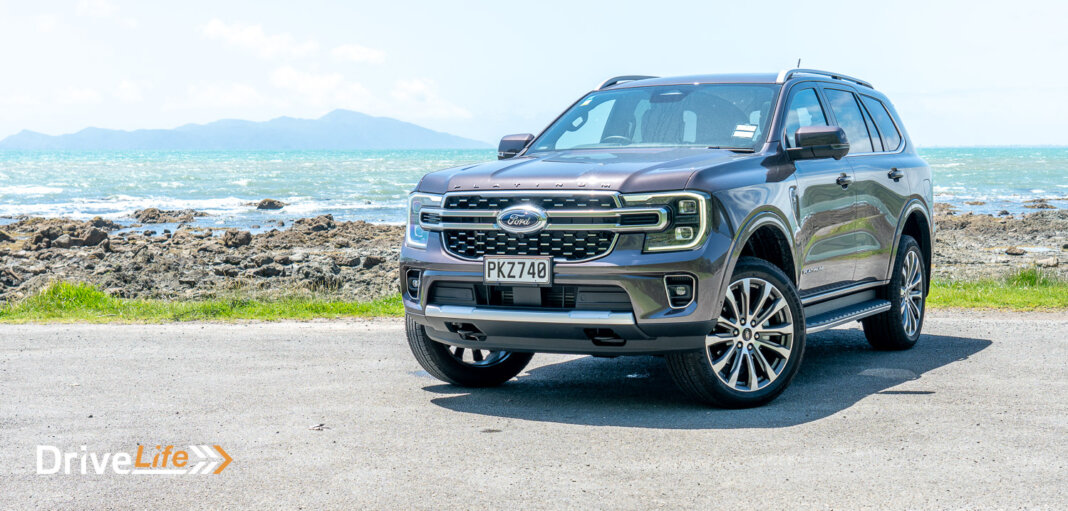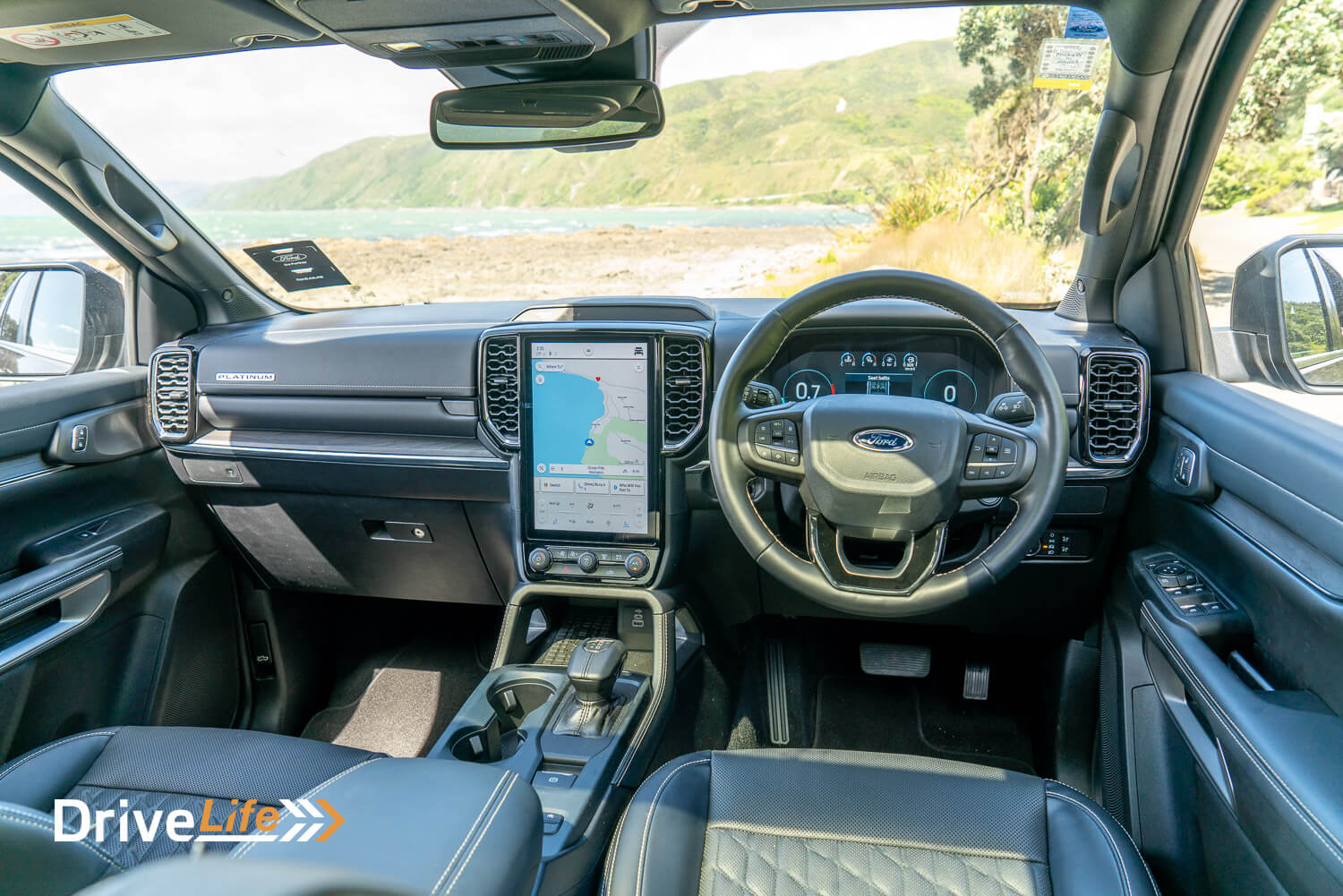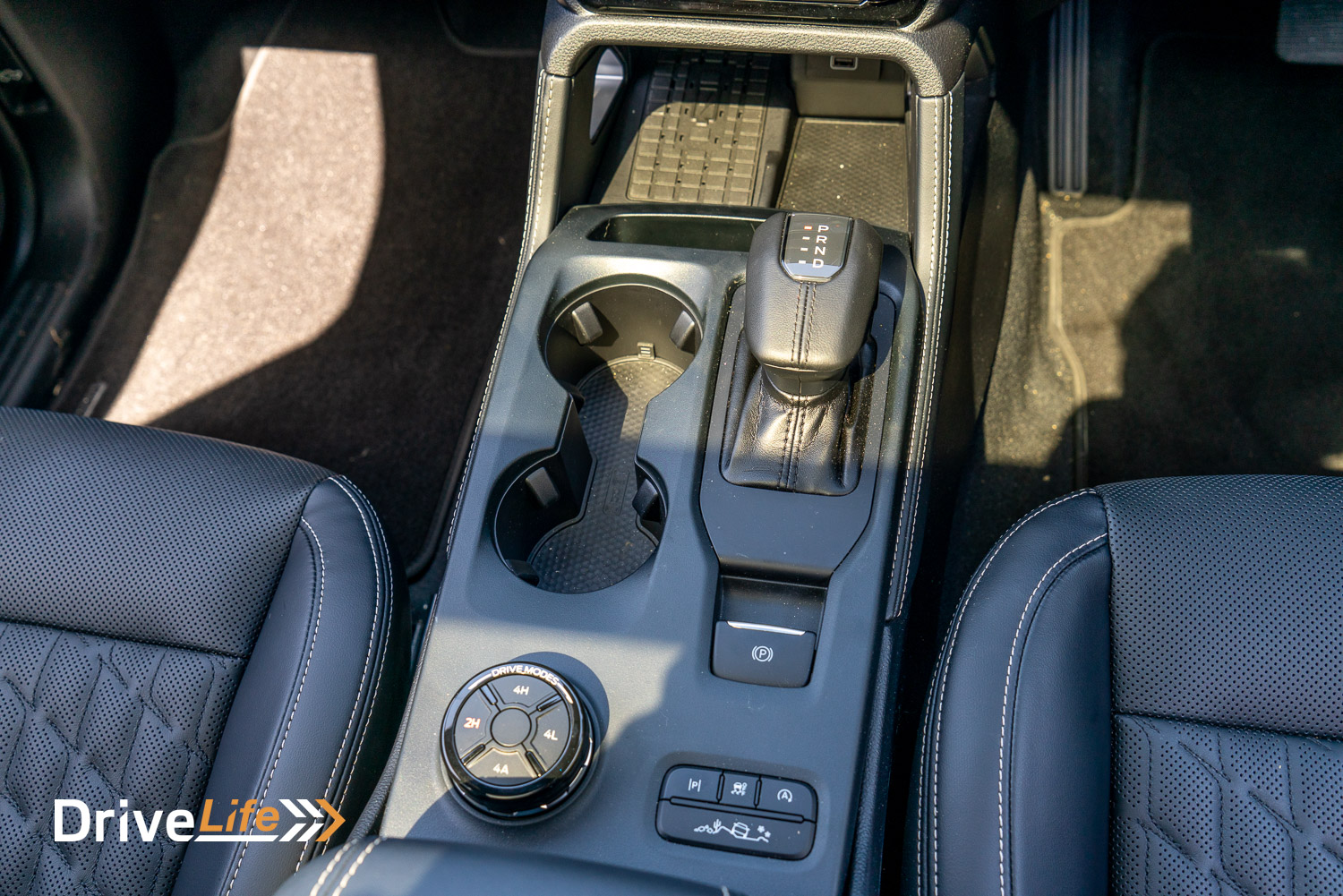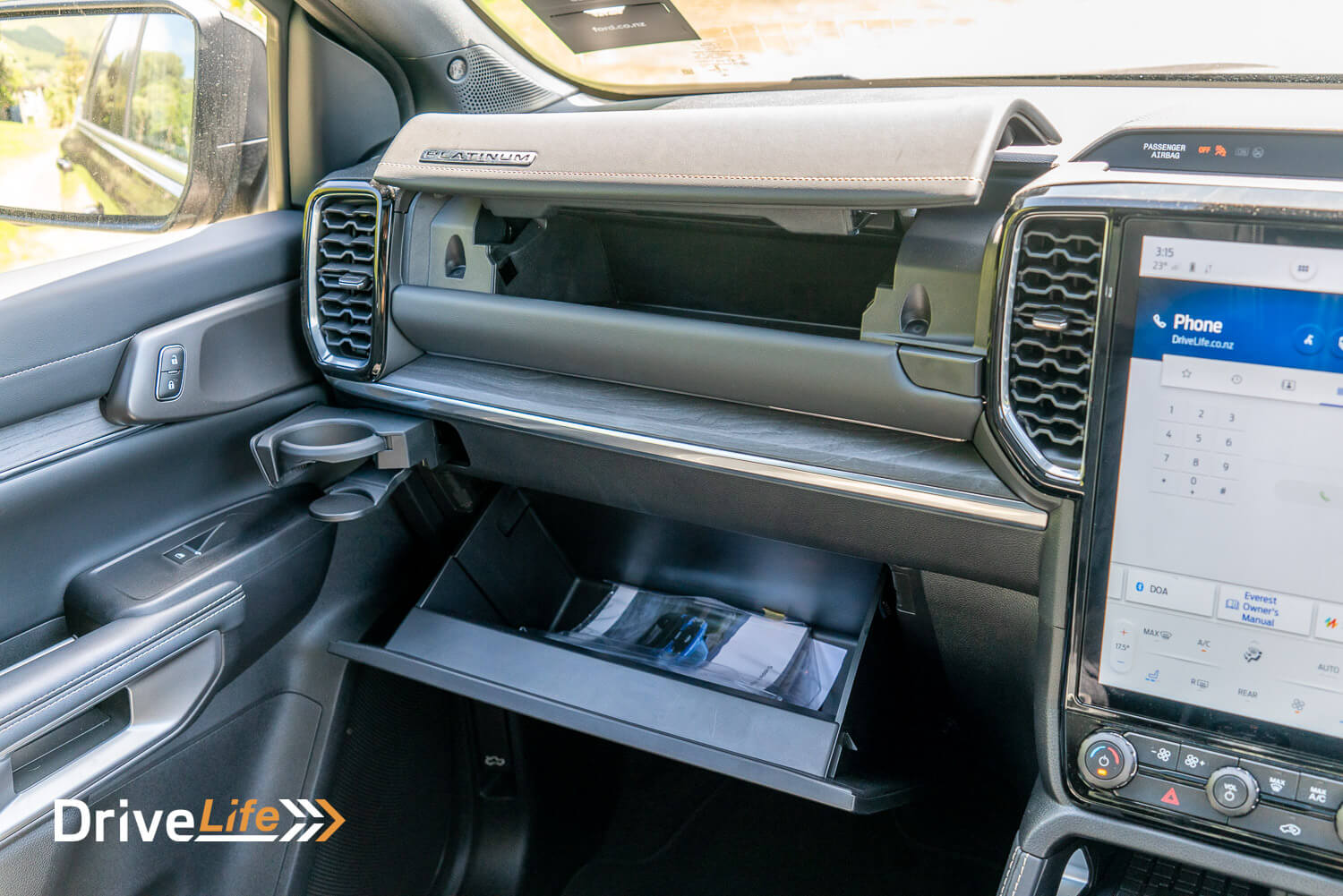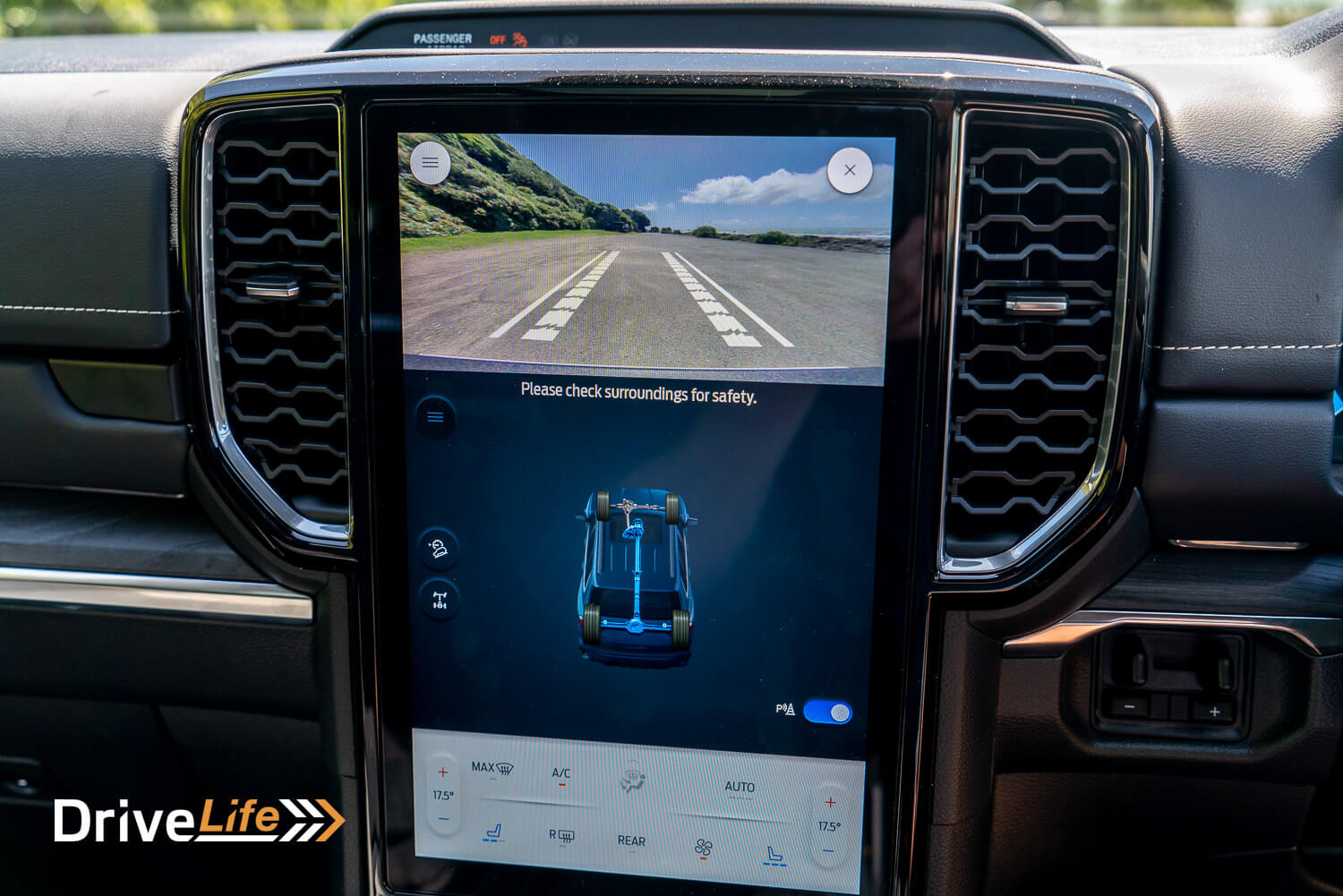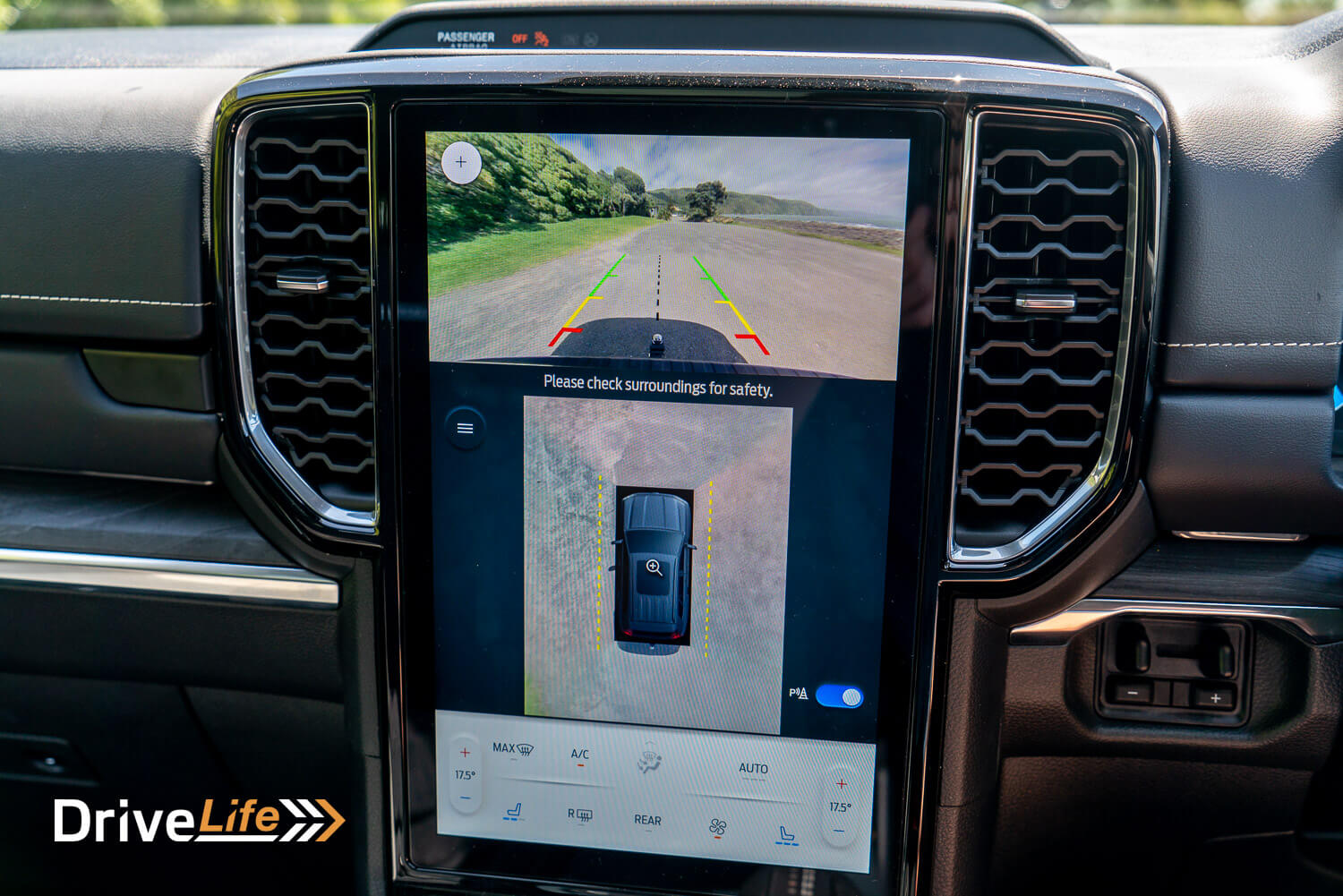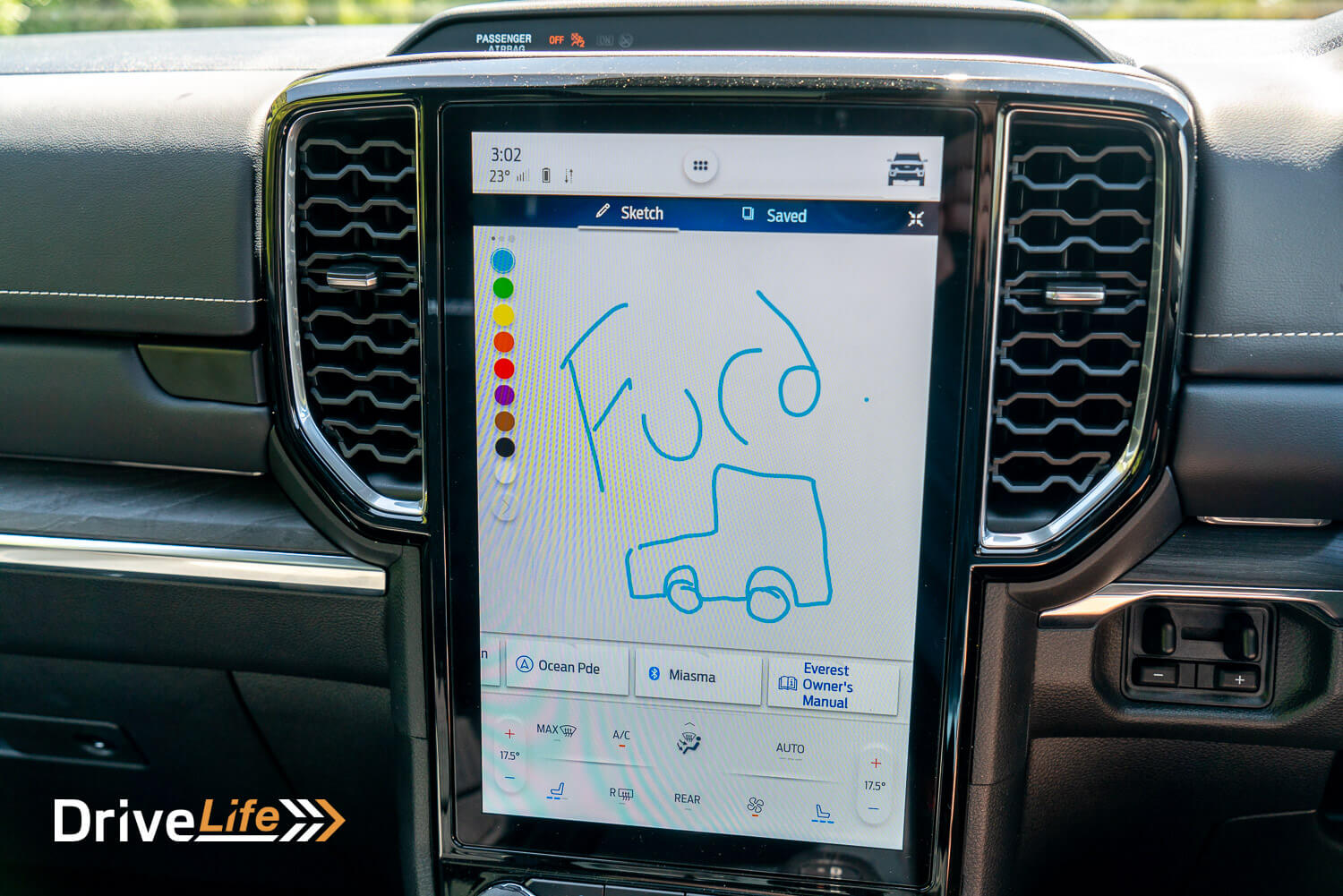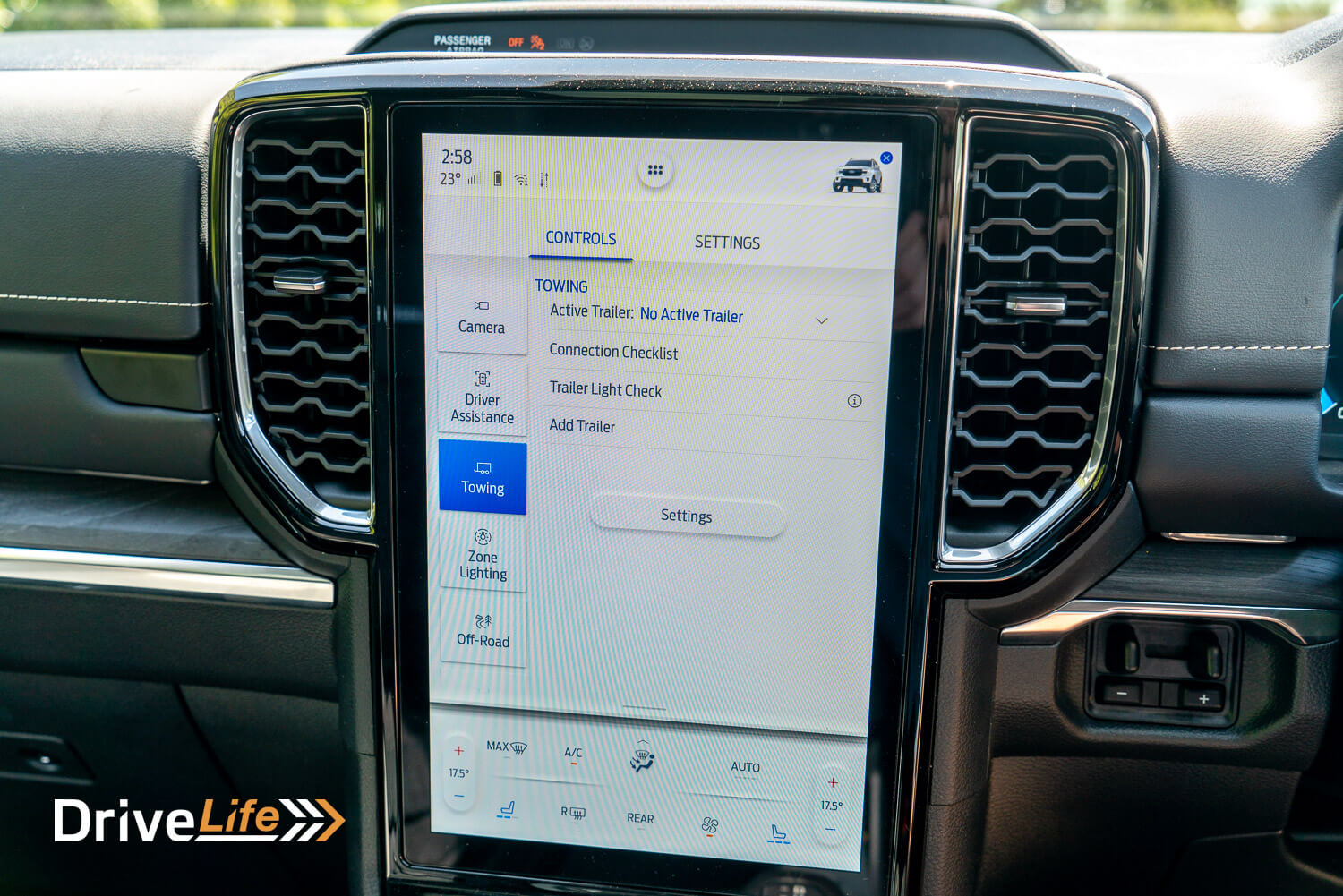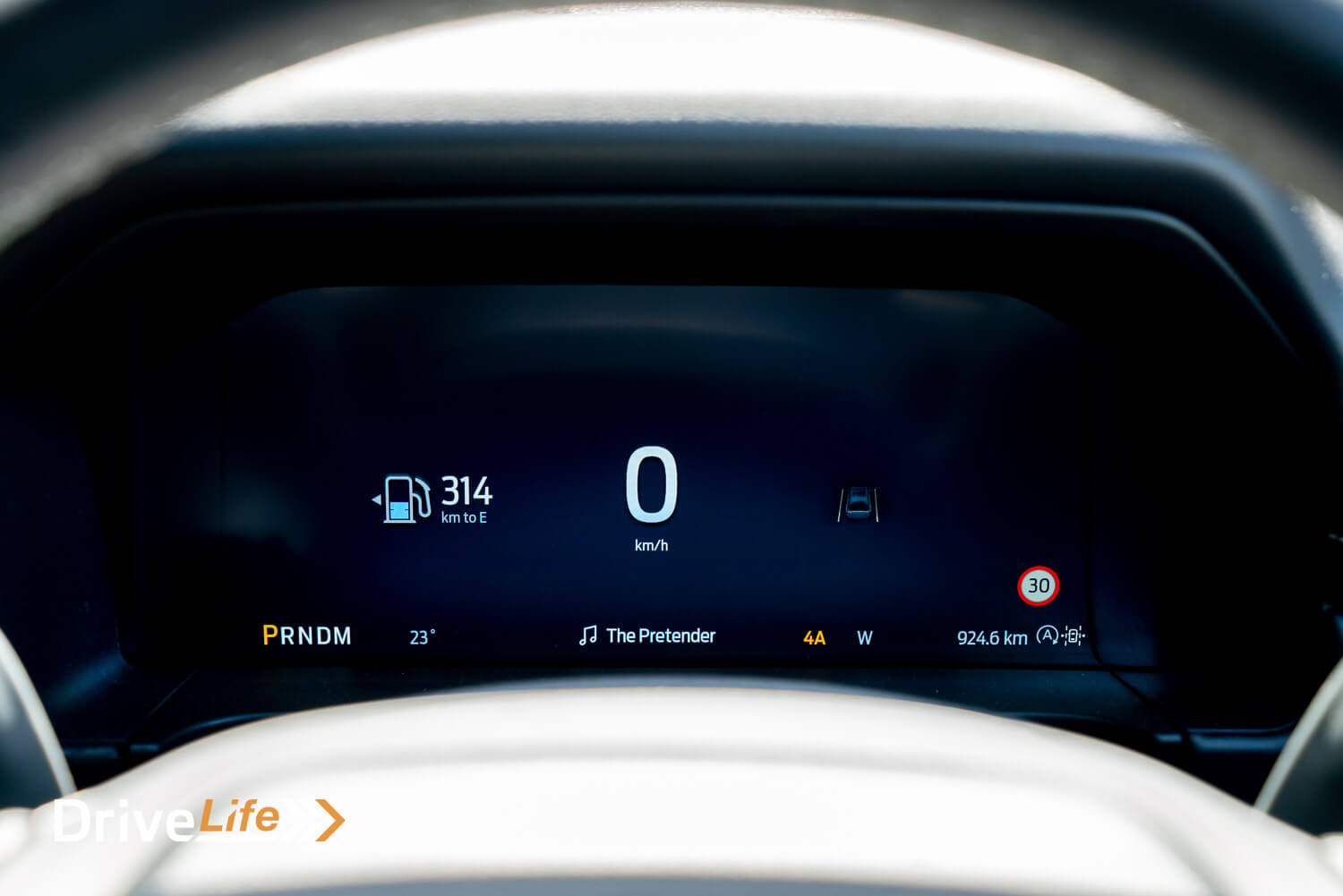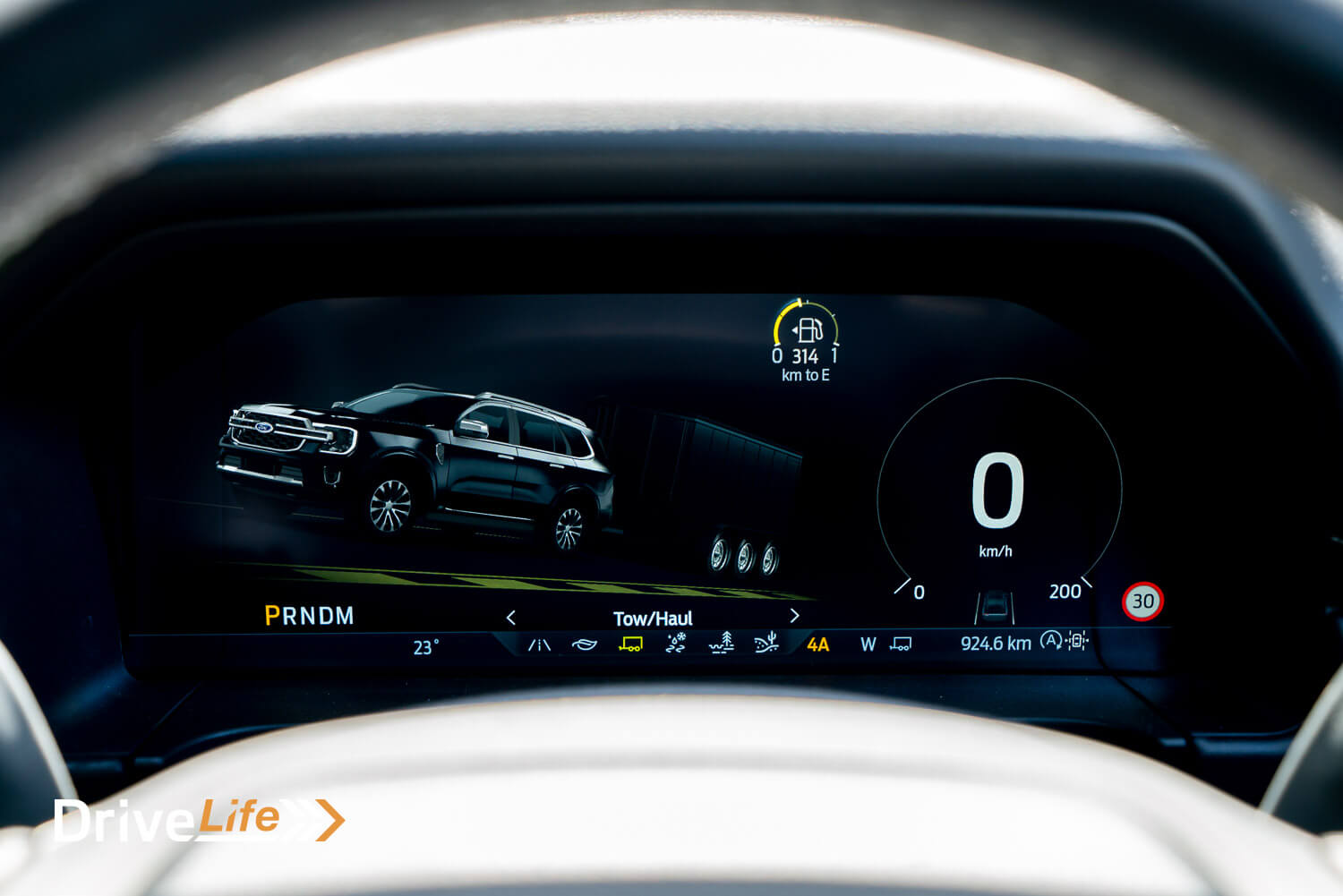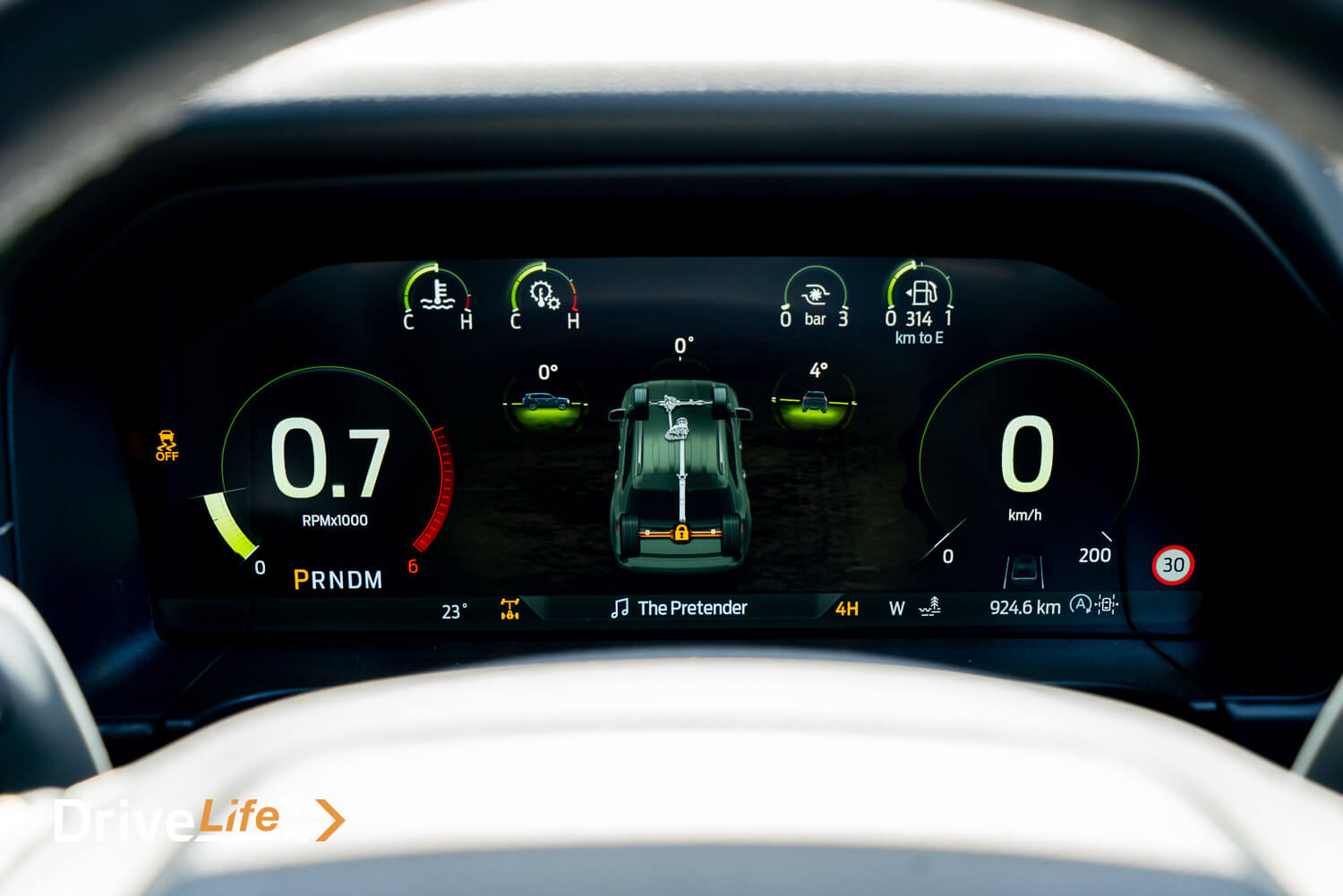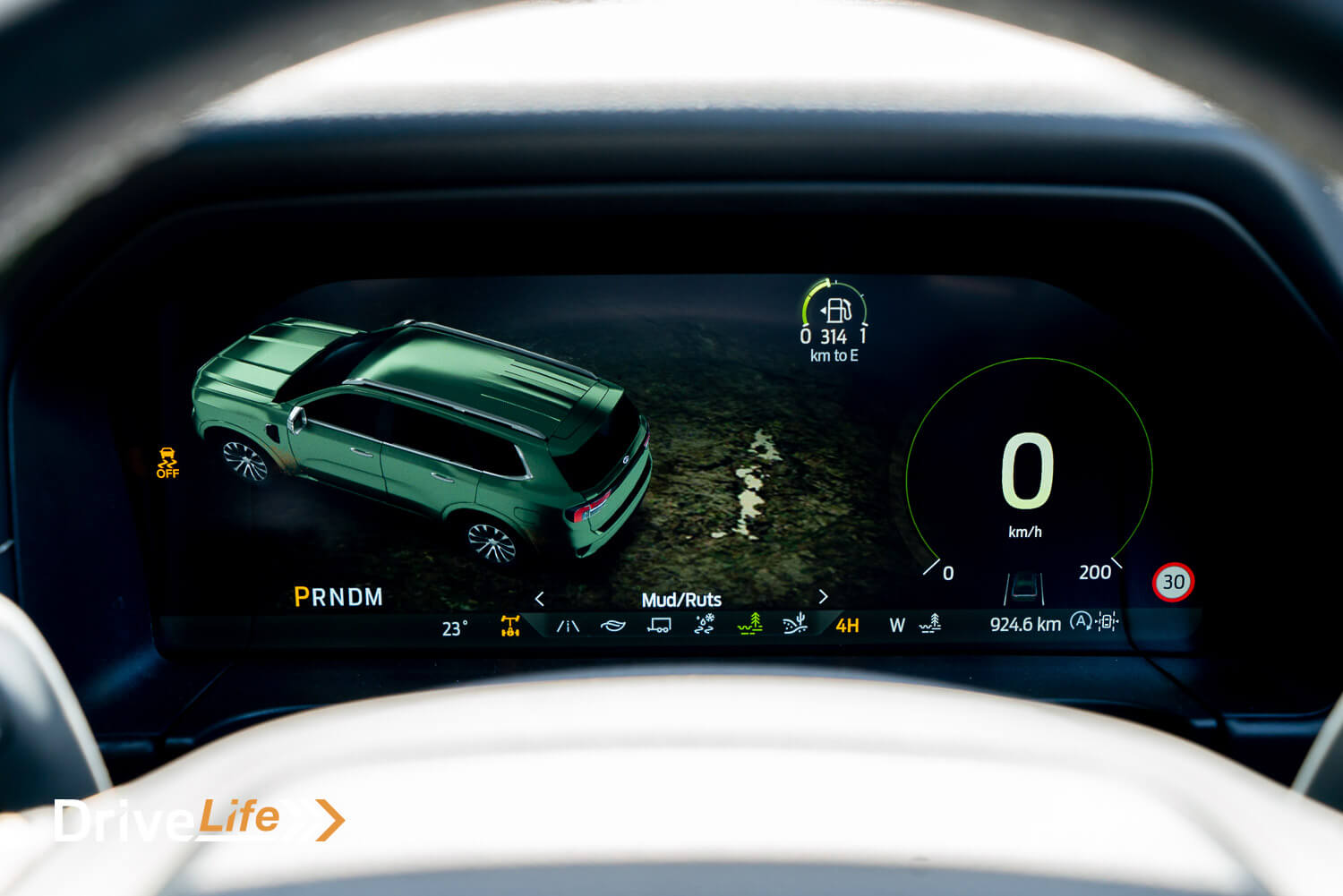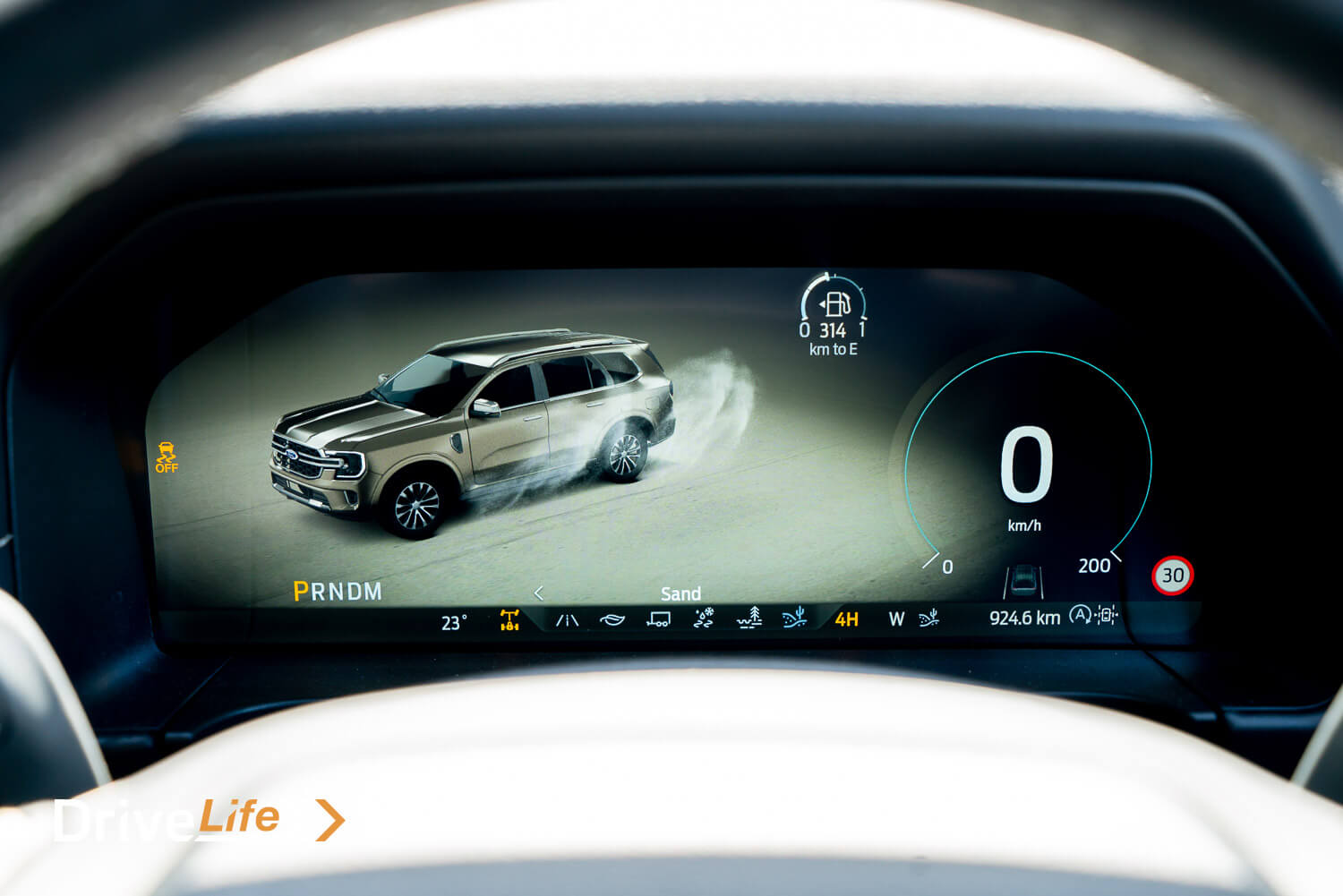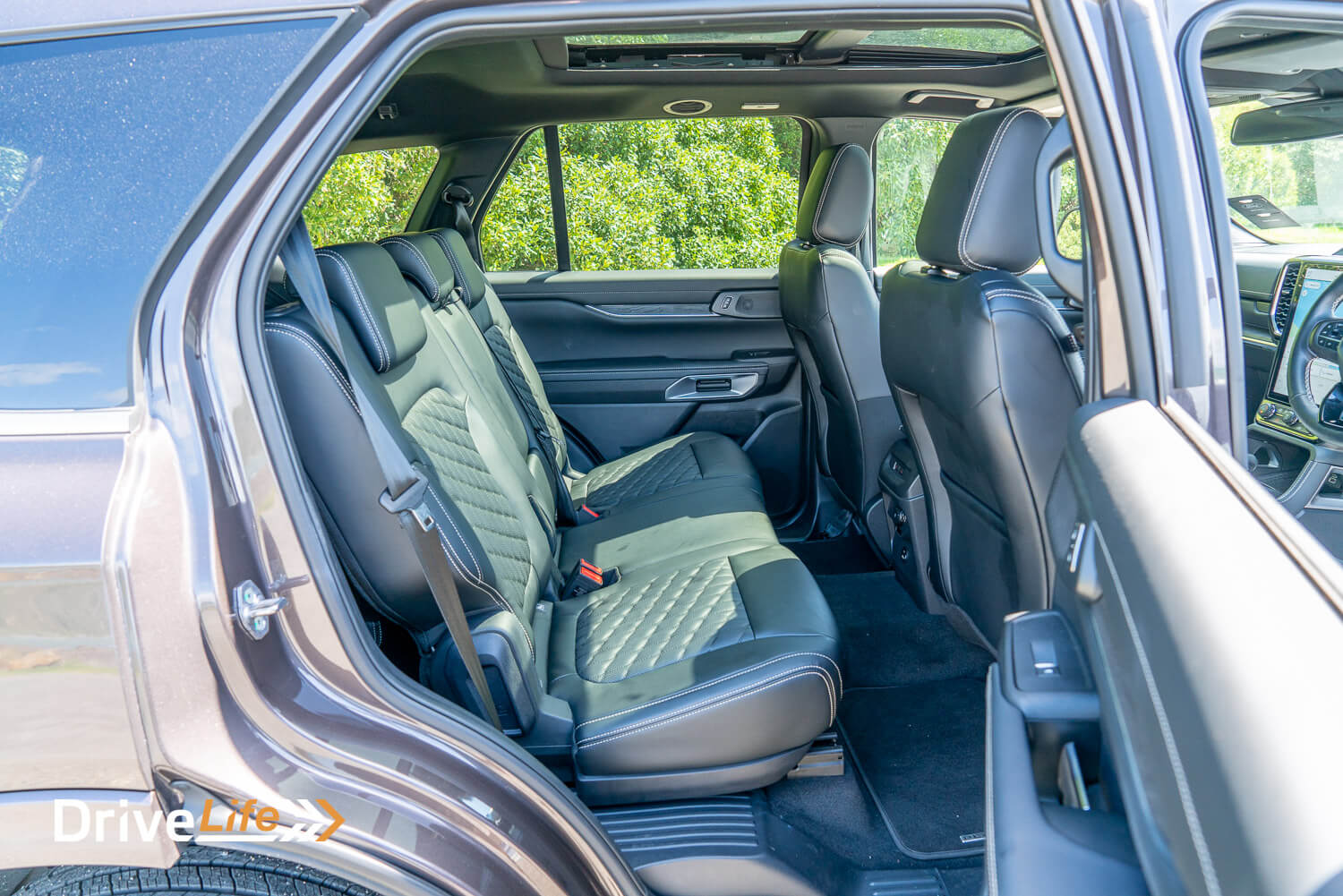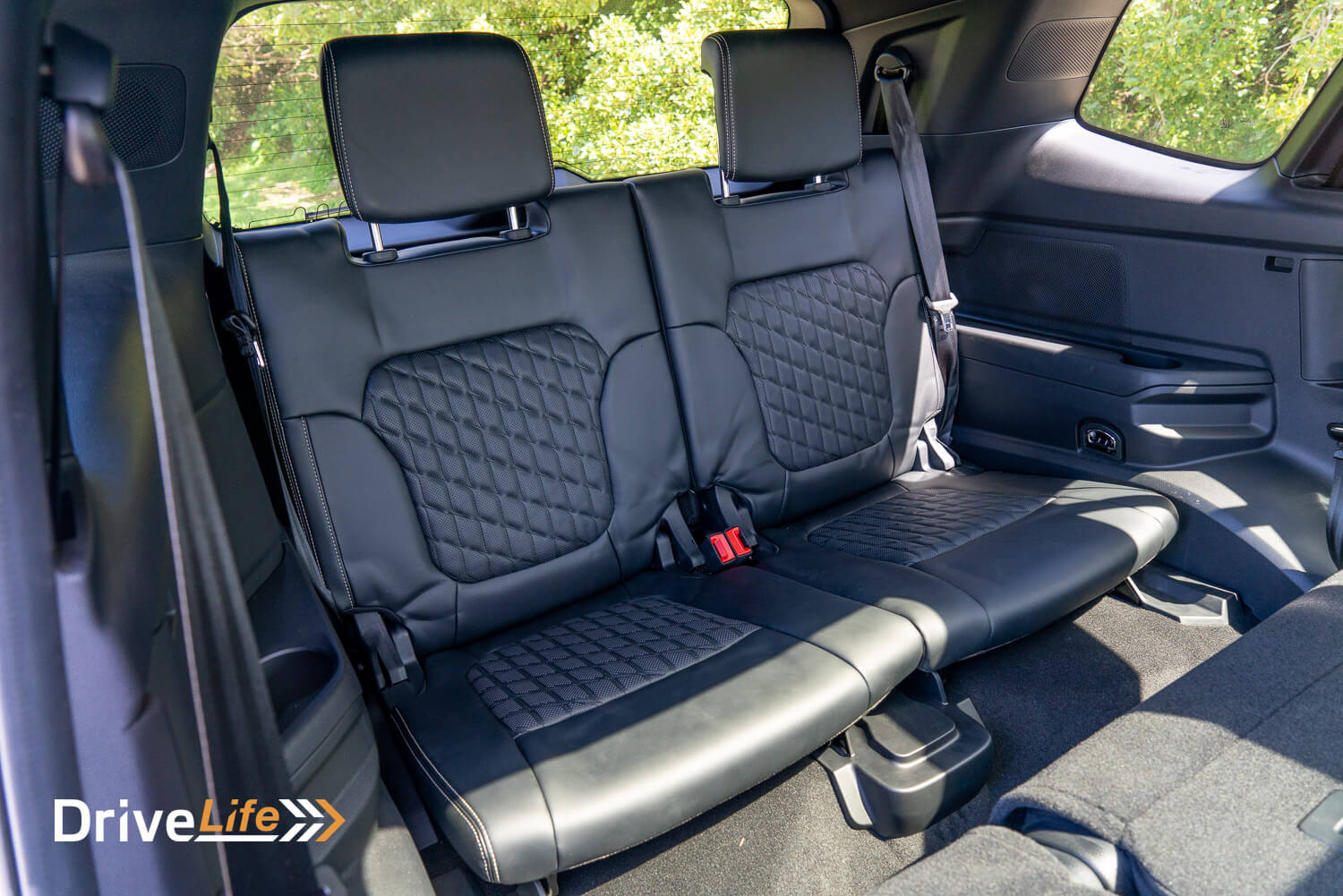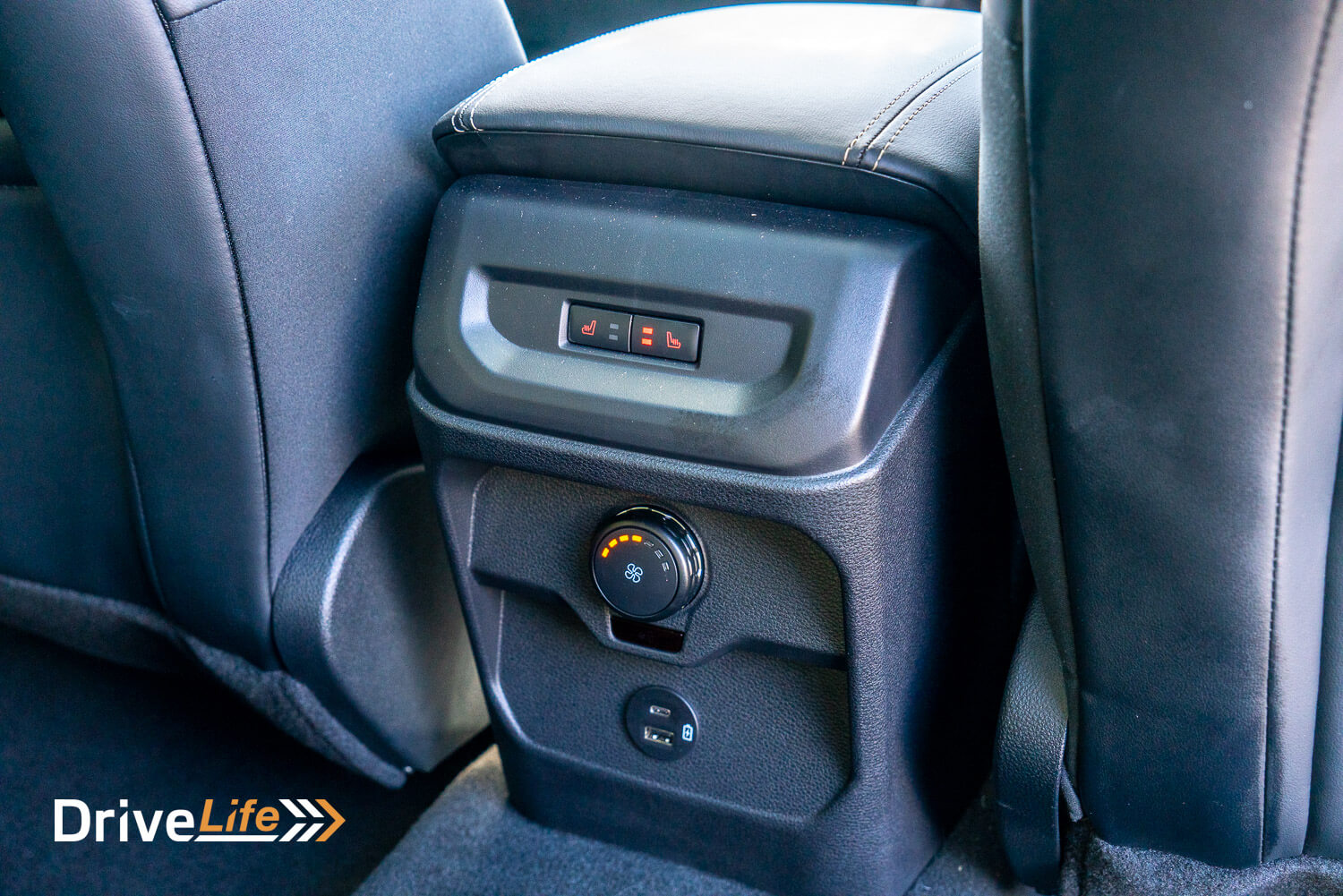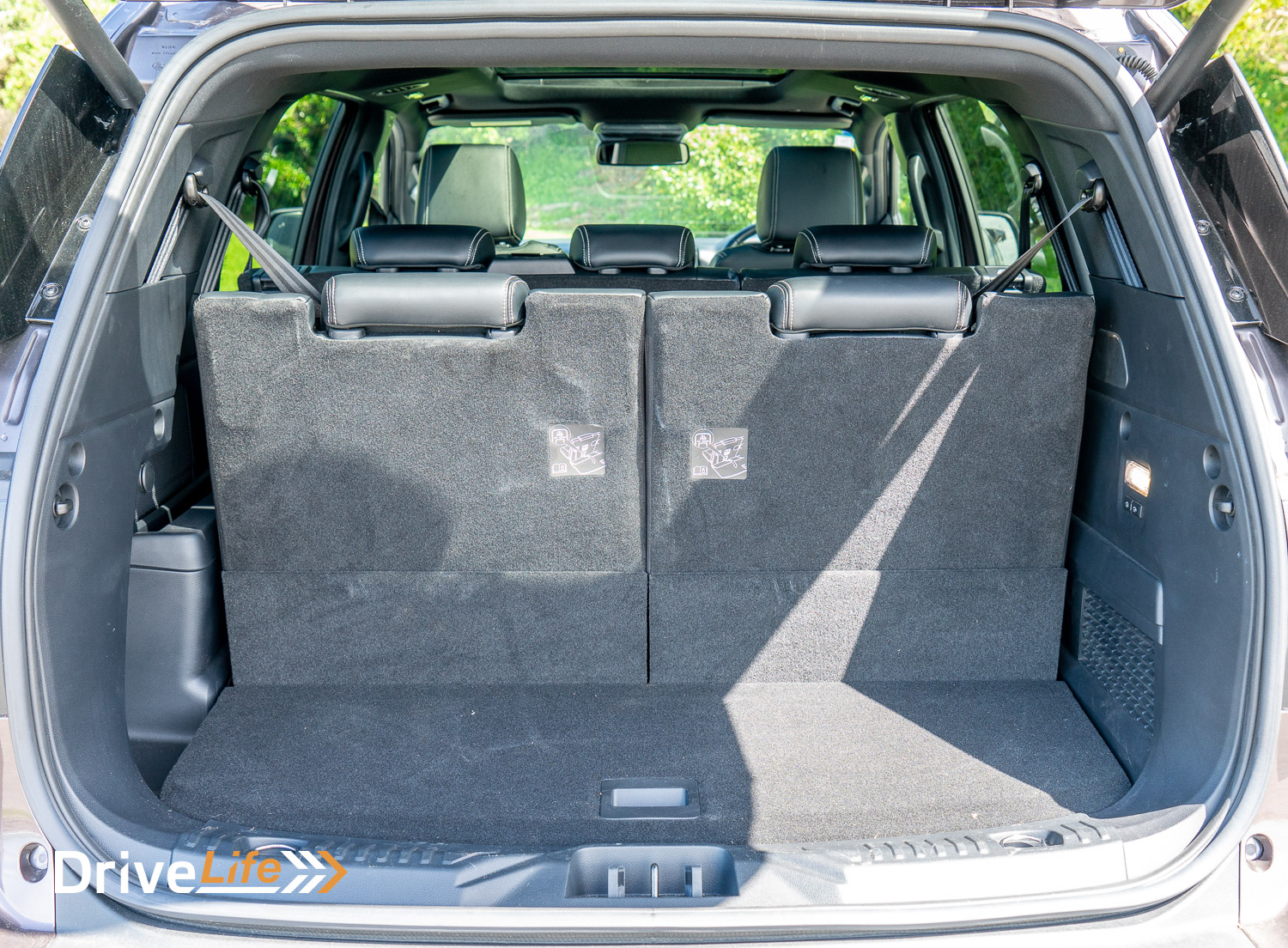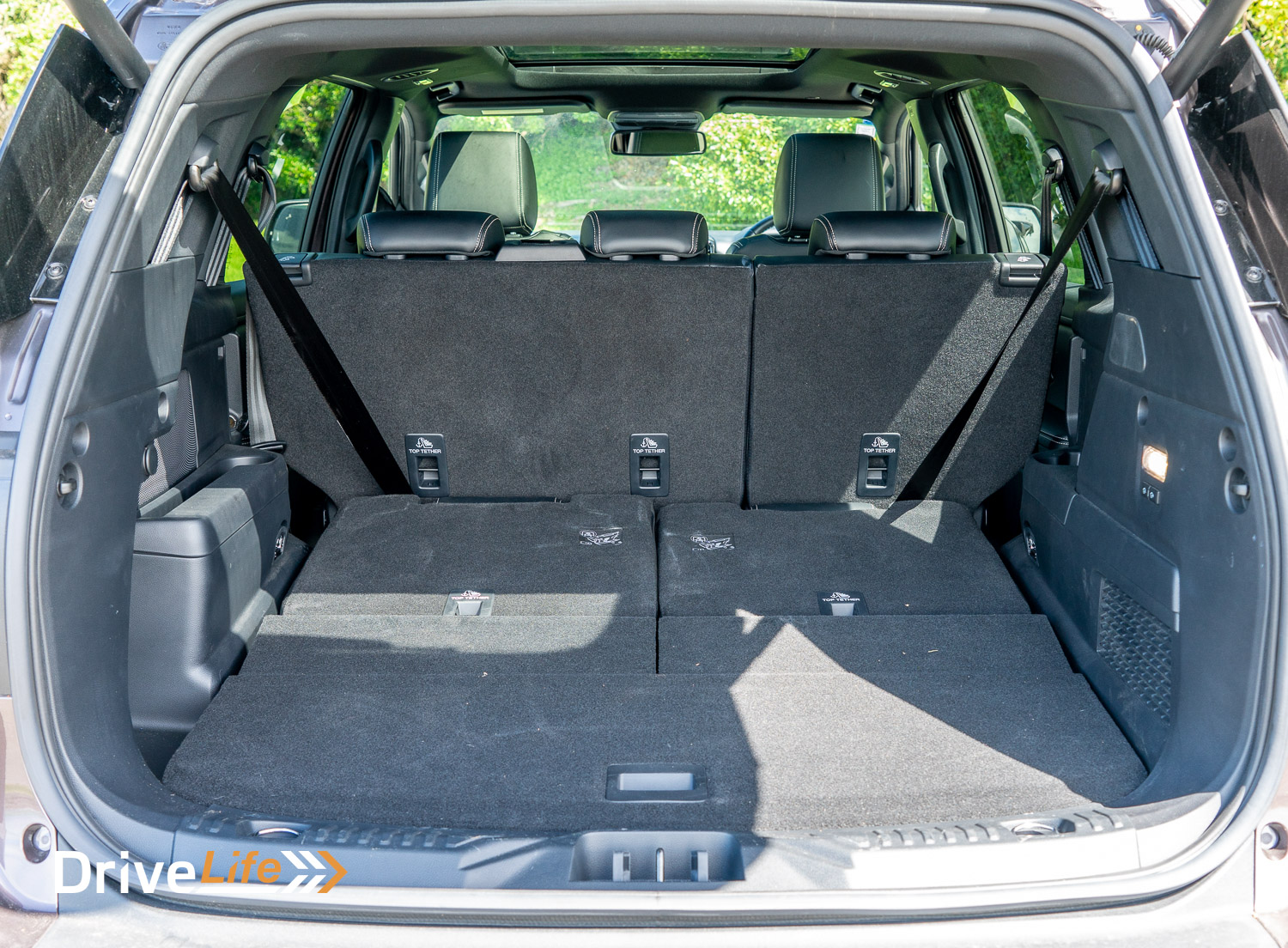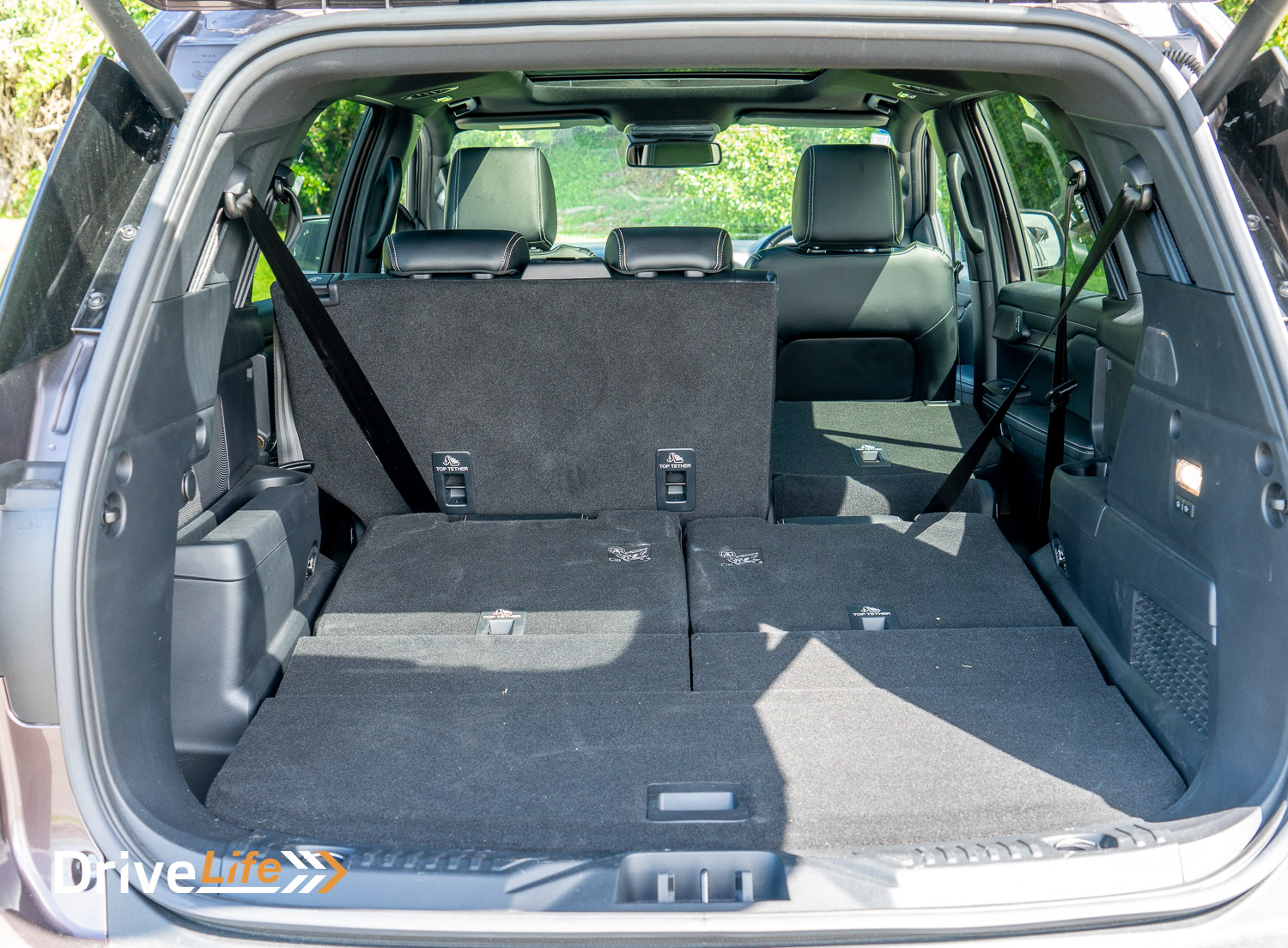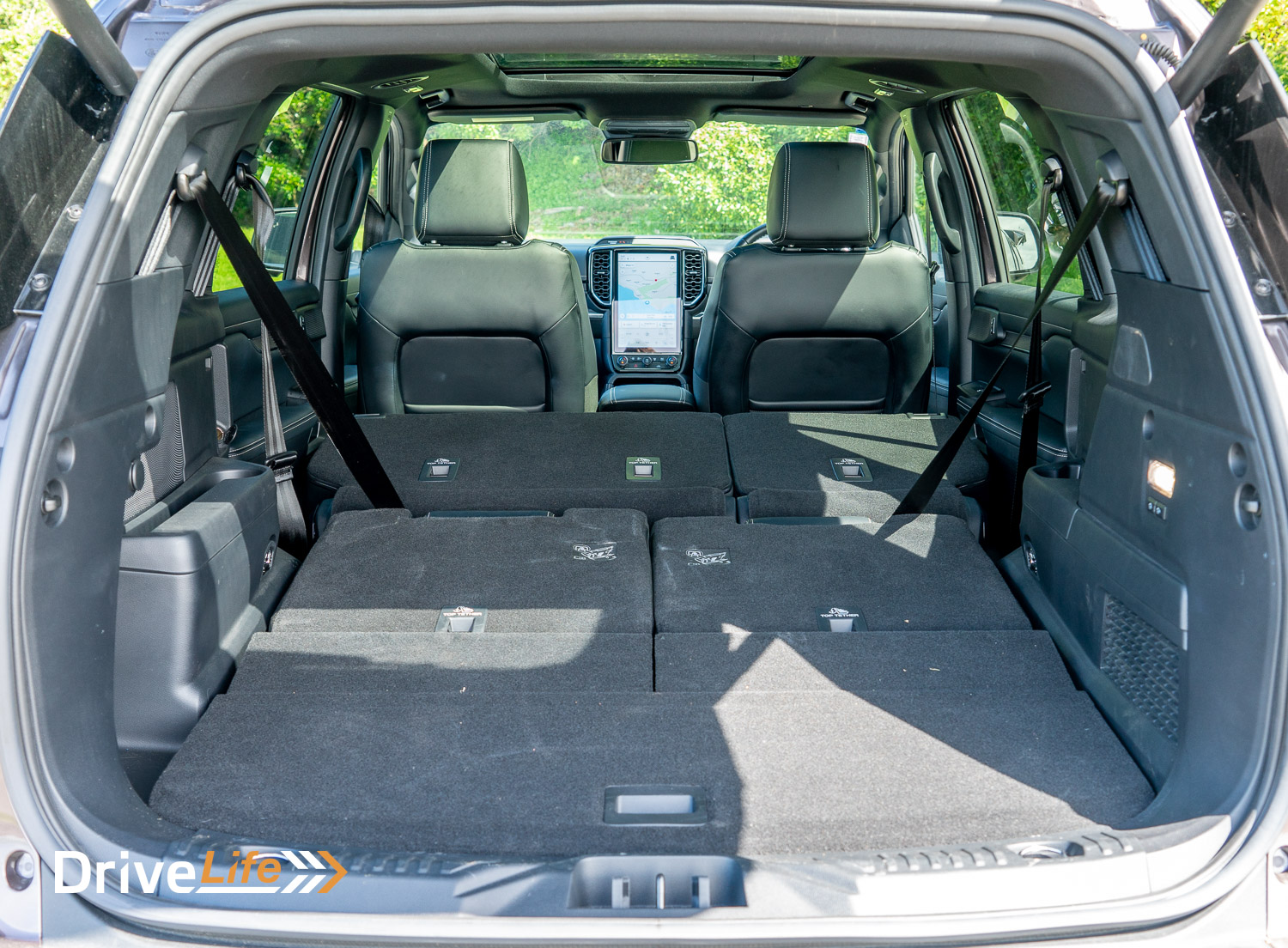Have you ever found yourself wanting a Ranger, but were swiftly reminded by your more sensible half, that a ute isn’t the most practical vehicle for a family?
I’m afraid that the sensible half has a point, particularly if you want to carry more than five passengers, or do a big shop while your kids are in the back seats.
Fortunately, Ford’s got you covered with the new 2022 Ford Everest. The Everest first arrived in 2015, where Ford essentially grafted on the body of a 7-seat SUV onto the back of a Ranger. The latest Everest is the same formula; It’s a Ranger with added family practicality.
Sounds compelling, doesn’t it? It’s compelling enough to contend for the 2022 New Zealand Car of the Year award.
So, is the Everest any good? We had over a week to find out.
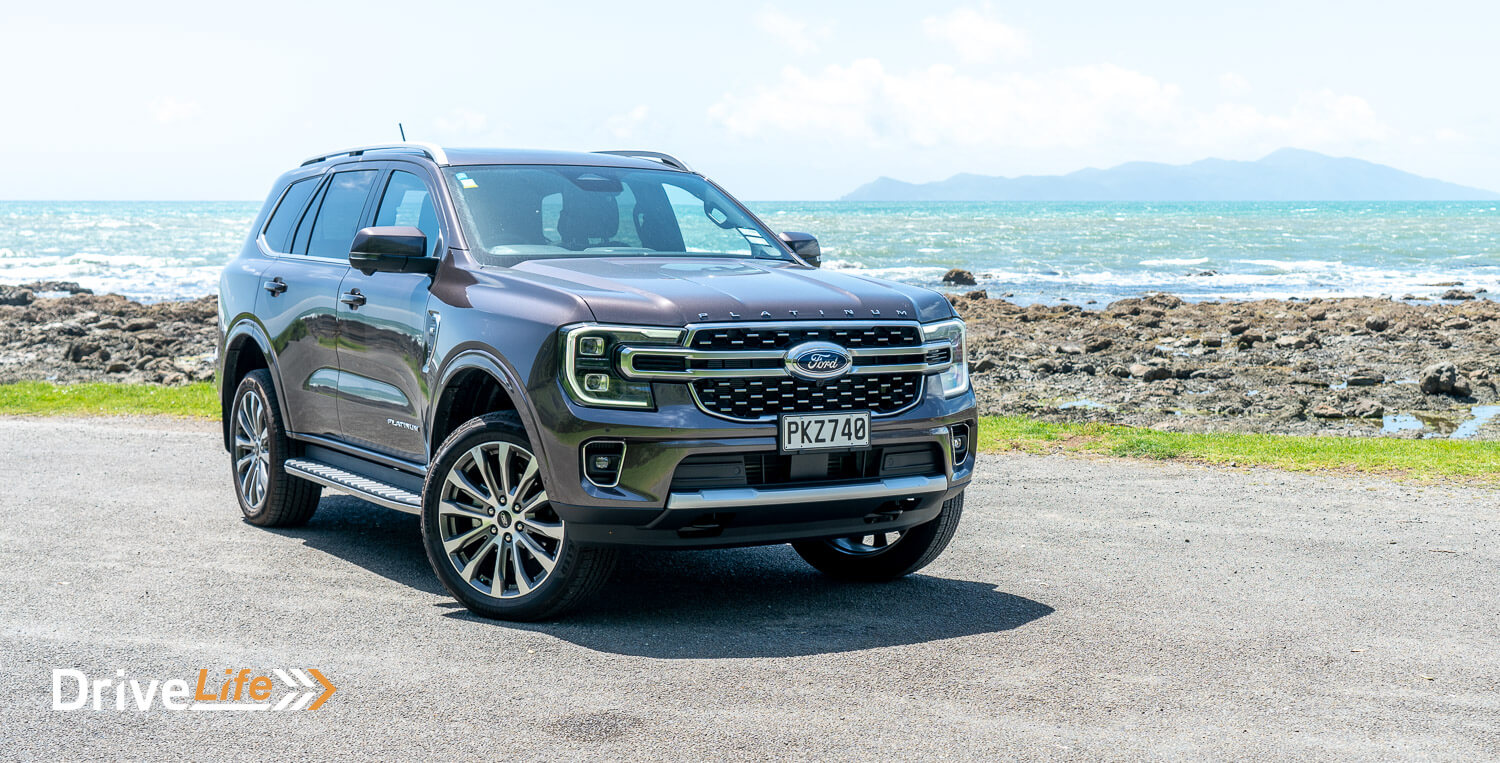
What We Like and Dislike About The 2022 Ford Everest Platinum
| What we like | What we don’t like |
| Smooth, silky V6 Spades of torque Ride quality Excellent transmission Infotainment Great B&O speakers | Narrow reversing camera view Flexible dash cluster bezel Slightly awkward driving position |
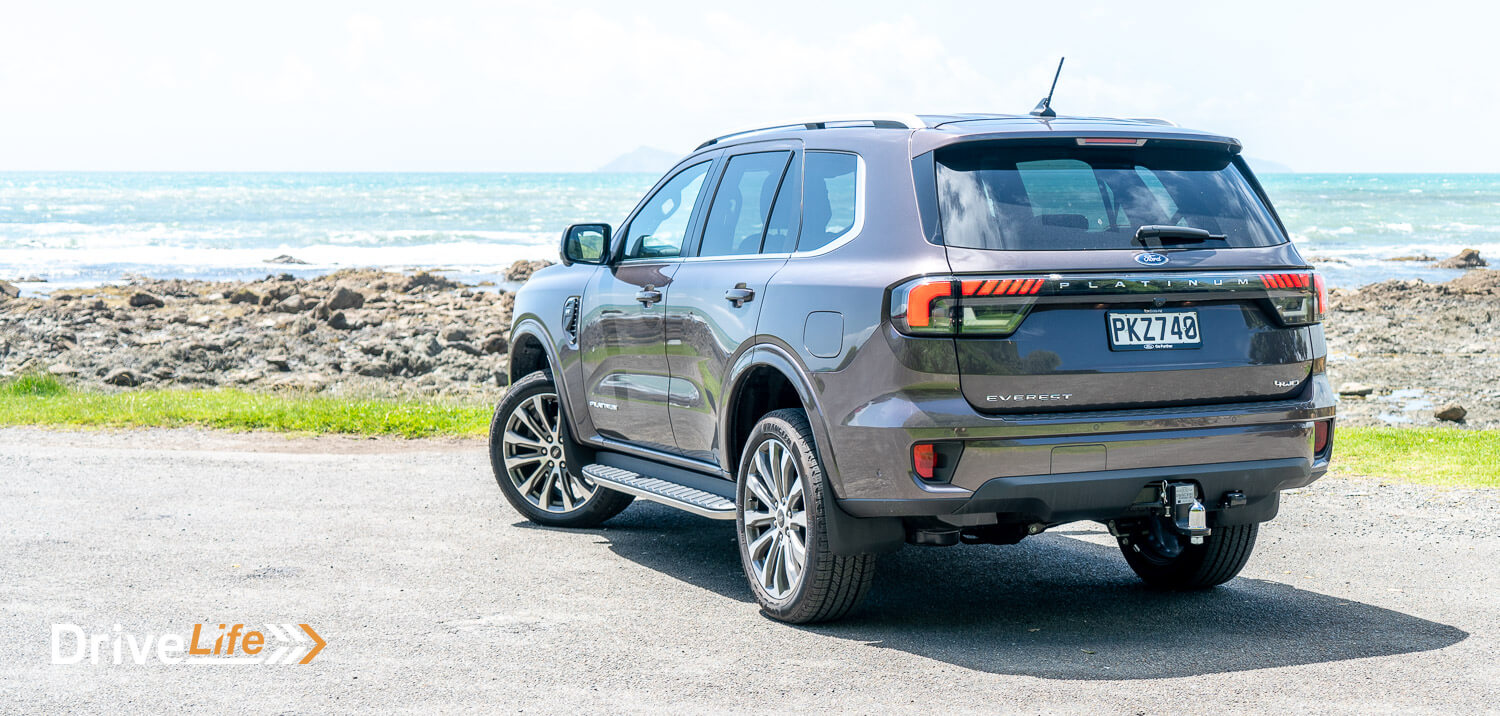
What’s In The 2022 Ford Everest Range?
There’s three models of the Ford Everest available for New Zealand buyers. The range starts with the Trend, mid-spec is the Sport, and topping the range is the Platinum.
| Model | Price* |
| Ford Everest Trend | $71,990 |
| Ford Everest Sport | $81,490 |
| Ford Everest Platinum | $86,990 |
There are two engine options available for the Everest. The Everest Trend is powered by a 2.0L 4-cylinder twin-turbo diesel, outputting 154kW of power and 500Nm of Torque. Move into the Everest Sport or the Everest Platinum, you’ll upgrade to a 3.0L V6 turbo-diesel, outputting 184kW of power and 600Nm of torque. Both engines are paired with a 10-speed automatic gearbox, and all Everest models are full-time 4WD.
At the time of writing, the Ford Everest Trend incurs a clean-car fee of $1,897.50, while the Everest Sport and Everest Platinum incur a fee of $4,025.
2022 Ford Everest Equipment Highlights
- 18” Alloy wheels
- 12” infotainment with Bluetooth
- 360-degree camera
- 4-way manual passenger’s seat
- 8” digital instrument cluster
- 8-speaker audio
- 8-Way power driver’s seat
- Auto headlamps and hi-beams
- Climate Control – Dual-Zone
- Electro chromatic rear view mirror
- Embedded modem
- Leather upholstery
- LED Daytime Running Lamps and Fog lamps
- LED Headlamps
- LED Taillamps
- Power and heated mirrors
- Rain sensing wipers
- Roof rails – Black
- Side steps
- Smart Keyless Entry with Push Button Start
- Wireless Apple CarPlay and Android Auto
- Wireless phone charging
- Zone lighting
Upgrading to the Everest Sport gets you:
- 20” Alloy wheels
- 10-Speaker audio
- 10-Way powered drivers seat
- 8-Way powered passengers seat
- Heated & cooled front seats
- Power liftgate
- Sport leather upholstery
Move up to the Everest Platinum, you add:
- 21” Alloy wheels
- Ambient lighting
- Chrome roof rails
- Heated steering wheel
- Heated 2nd row seats
- Matrix LED headlamps
- Panoramic sunroof
- Power folding 3rd row
- Premium floormats
- Quilted leather seats
- 10-way power passenger seat
- 12 speaker B&O premium Audio System
- 12.4” digital instrument cluster
There are seven colours available for Ford Everest range, these are:
- Arctic White
- Aluminum
- Meteor Grey
- Shadow Black
- Blue Lighting (only for Sport variant)
- Sedona Orange
- Equinox Bronze (only for Platinum)
Standard safety equipment includes:
- 9 Airbags
- Adaptive Cruise Control with Stop/Go
- Traffic Sign Recognition
- Lane Centring Assist
- Intelligent Speed Assist
- Blind Spot Monitoring with Cross Traffic Alert and Trailer Coverage
- Emergency Brake Assist
- Forward Collision Warning
- Hill Descent Control (4X4 only)
- Load Adaptive Control
- Roll Over Mitigation
- Traction Control
- Trailer Sway Control
- Evasive Steer Assist
- Lane Keeping Aid with Road Edge Detection and Driver Alert System
- Pre-Collision Assist with Autonomous Emergency Braking (AEB) and Intersection Assist
- Reverse Brake Assist
- Traffic Sign Recognition
Upgrading to Platinum spec adds:
- Active Park Assist
- Tyre Pressure Monitoring System
For more information on the Everest check out the Ford New Zealand website.
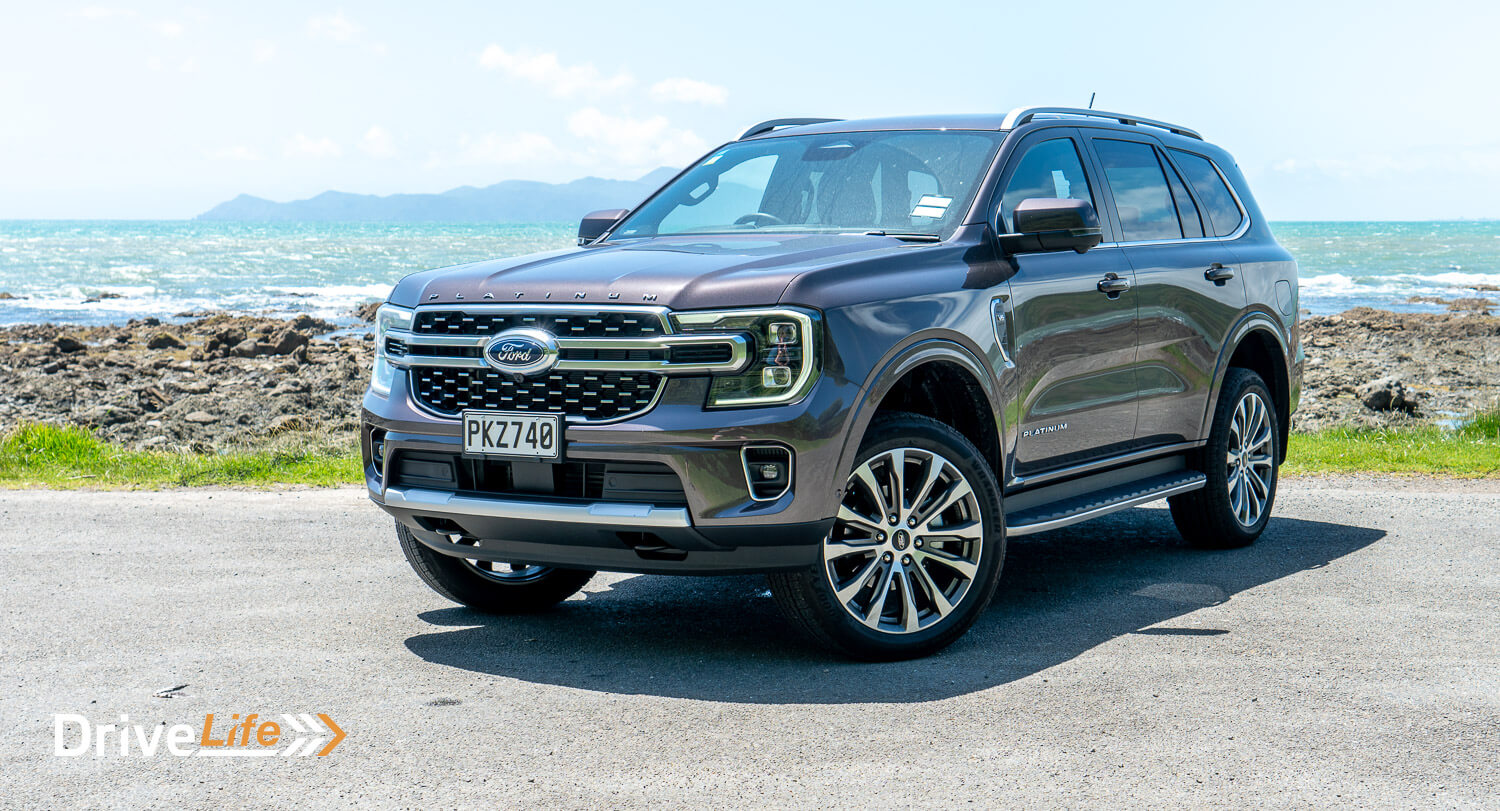
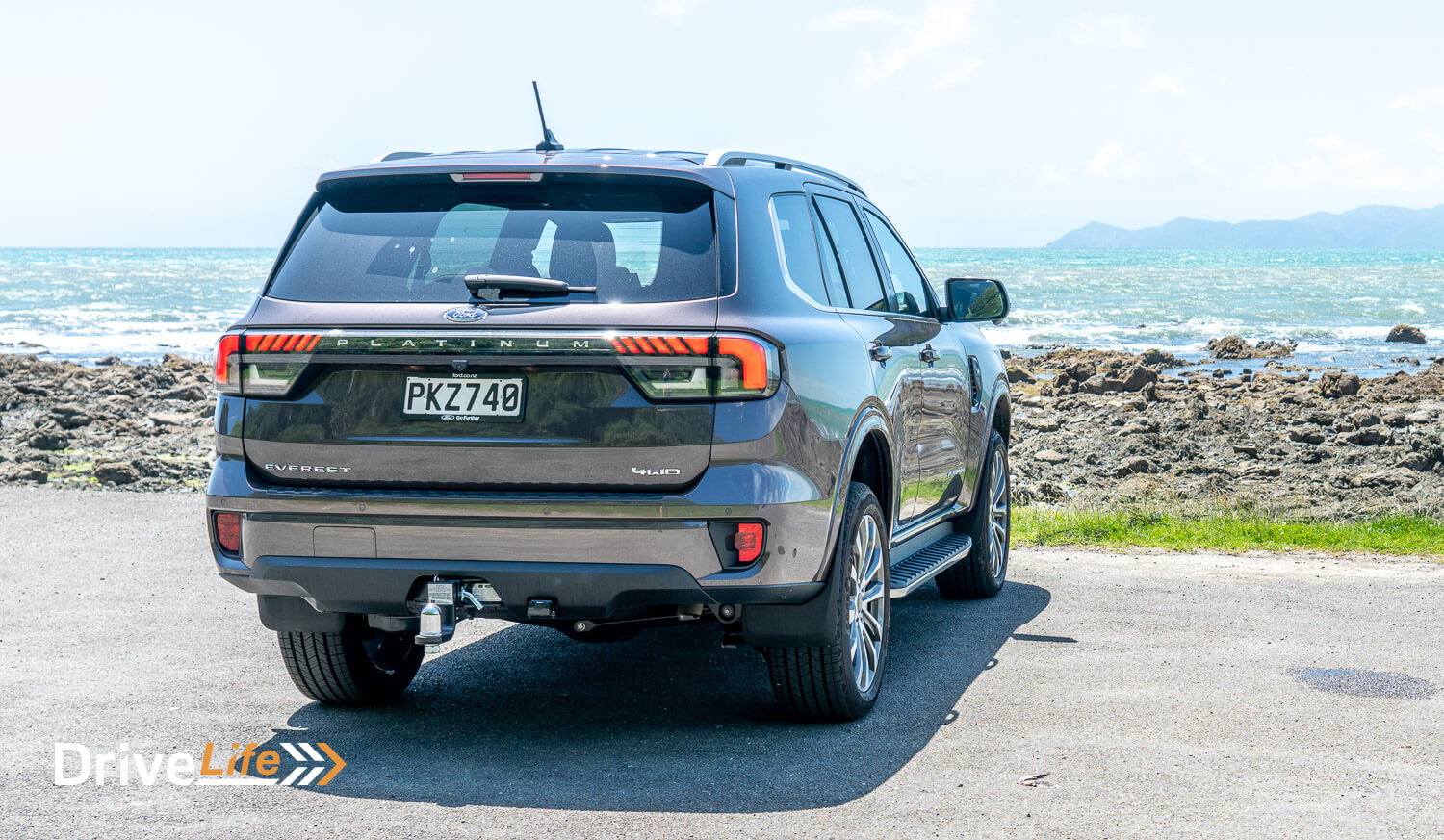
How Does The 2022 Ford Everest Platinum Compare To Its Competition?
There might be plenty of 7-seaters on the market, but not nearly as many that can go off-road. Here’s some of your options.
| Make/ Model | Engine | Power/Torque kW/Nm | Seats | Fuel L/100km | Towing Capacity | Boot Space litres | Price (excl CCP) |
| Toyota Land Cruiser Prado VX Limited | 2.8-litre turbodiesel 4-cylinder | 150/500 | 7 | 9.1 | 750/3100 | 553 | $97,390 |
| Ford Everest Platinum | 3.0-litre turbodiesel V6 | 184/600 | 7 | 9.7 | 750/3,500 | 898 | $86,990 |
| Isuzu MU-X | 3.0-litre turbodiesel 4-cylinder | 140/450 | 7 | 9.5 | 750/3,500 | 1,119 | $80,990 |
| Toyota Fortuner Limited | 2.8-litre turbodiesel 4-cylinder | 150/500 | 7 | 8.7 | 750/3100 | 716 | $63,190 |
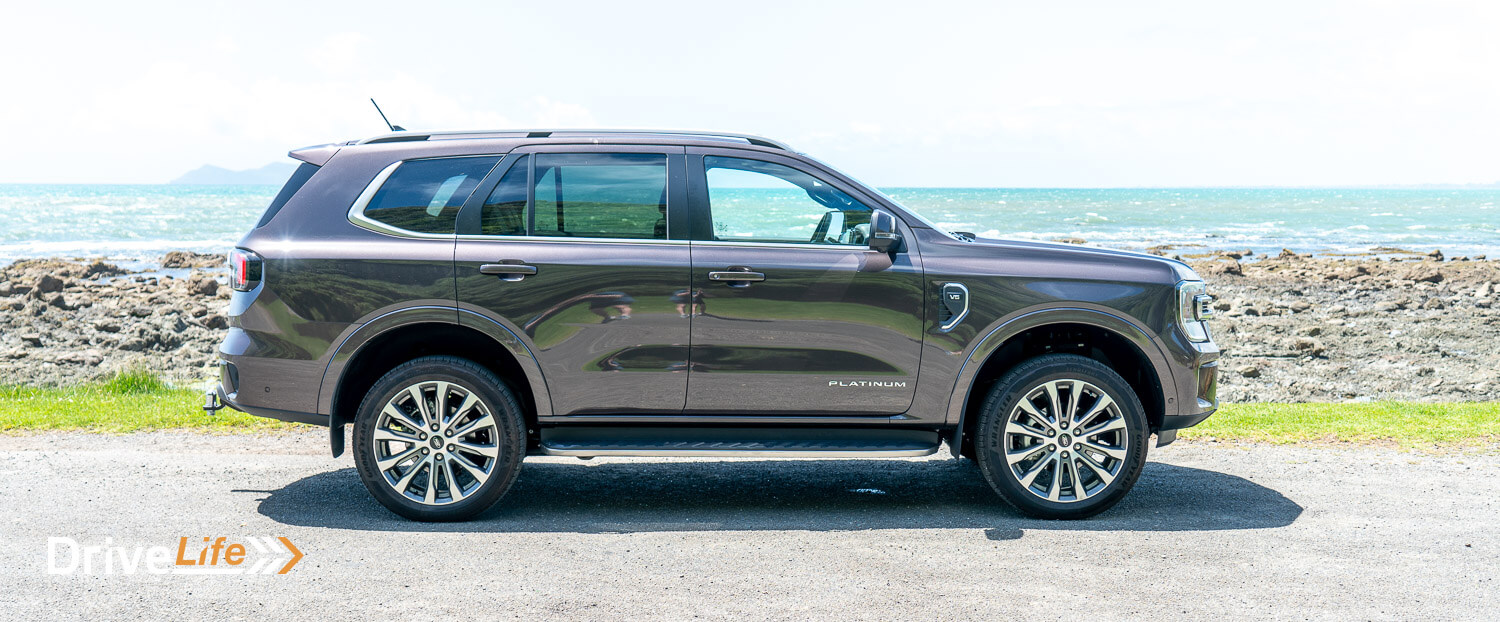
First Impressions Of The 2022 Ford Everest Platinum
You know a car stands out when it passes the ‘look-back’ test. Ya know, that reflective moment one has when you look back to admire your machine after parking it. If you find yourself doing this, you’ve got a winner.
For me, the Ford Everest was a winner. Its fresh front-end with its C-Clamp headlights imitates the F-Series range, giving the Everest a stronger presence. The accessories are also tastefully executed, highlights being the premium alloys and the use of LED lighting. Finish the body with the unique Equinox Bronze colour as shown on our test vehicle, and I’ll guarantee you’ll be thinking ‘yeah, that’s a nice truck’.
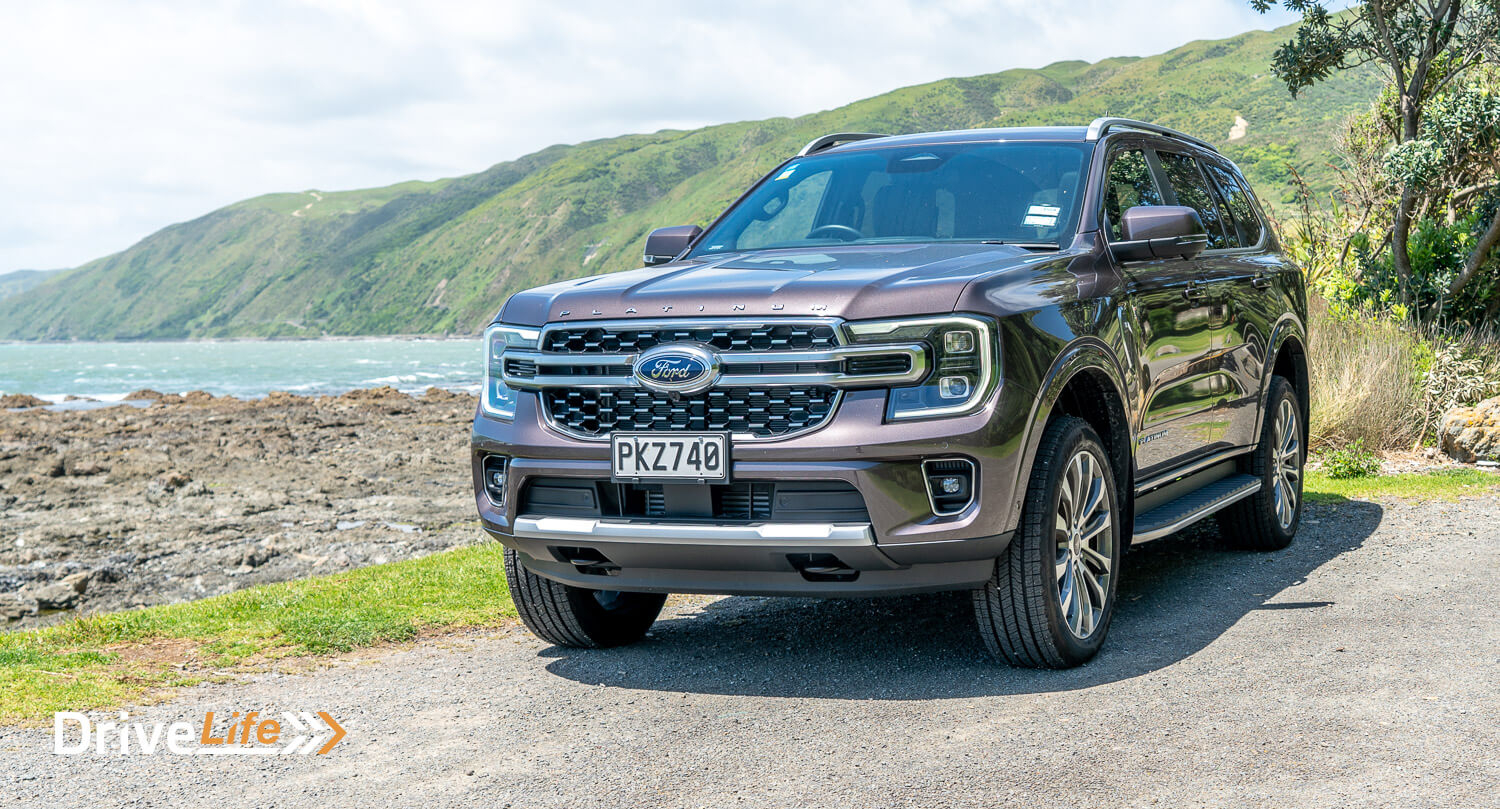
What’s The Interior Like In The 2022 Ford Everest Platinum?
In the past, had you described a car having the interior of a ute, it would’ve been quite a derogatory thing to say. After all, the ute is a working vehicle, designed for bashing paddocks and hauling loads, with the cabin often reflecting this general bashableness. Or should I say, the ute was a working vehicle.
These days, the line between car and ute has never been blurrier and we have the Ford Ranger, amongst others, to thank for that. The Everest is essentially a Ranger with an SUV body grafted onto the back. From the cockpit, there’s not much design-wise to distinguish the two. But that’s far from a bad thing.
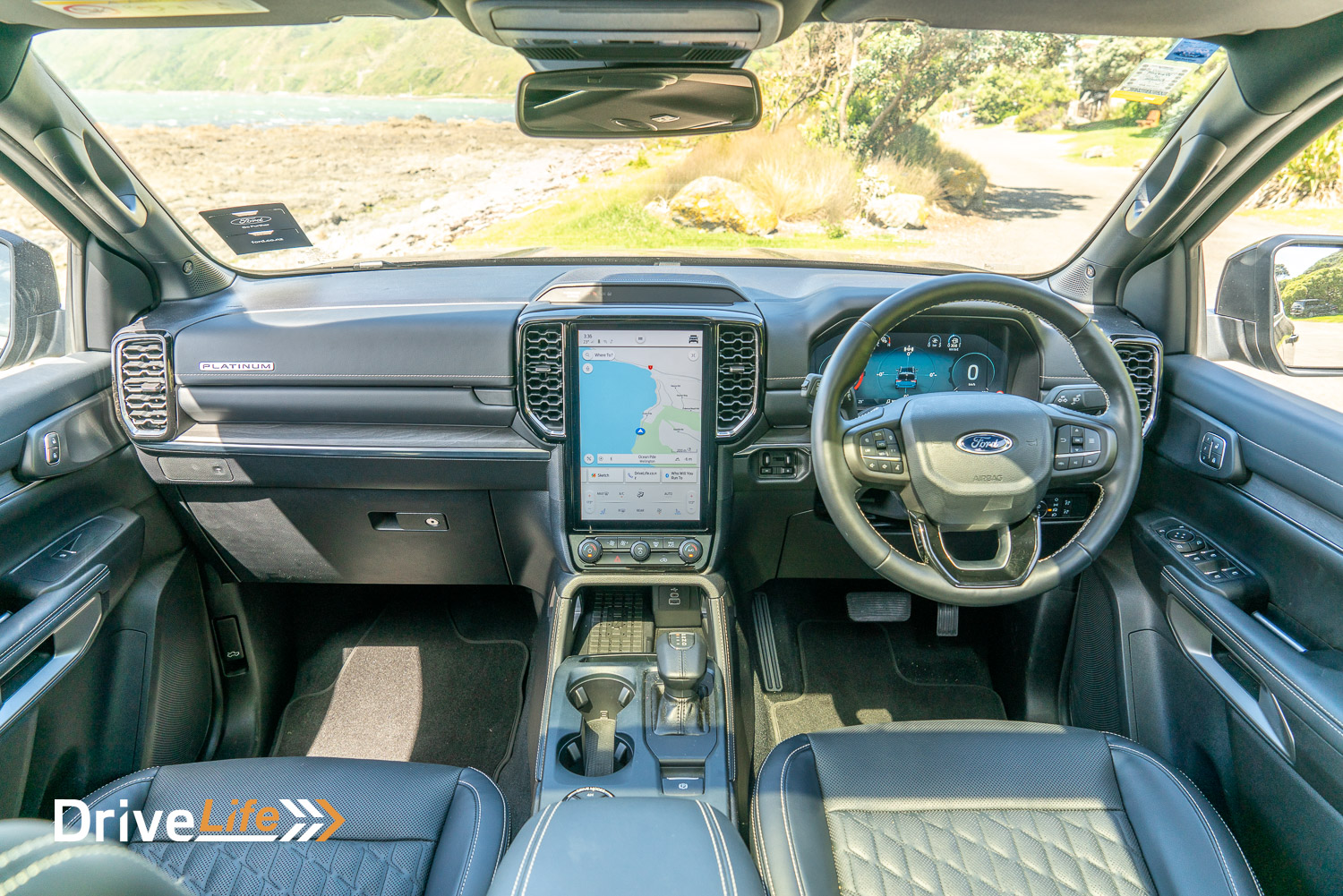
The interior of the Everest is the highest quality and most technology laden of any Ute-based SUV we’ve seen yet. The most obvious change is the massive central infotainment screen dominating the real estate formerly reserved for the climate controls and other accessories. In front of the driver is another screen, being the upsized 12’’ digital dash cluster for the Platinum model.
In terms of quality, the cabin is all well put together. Many of the trims are of decent quality, with a few hard plastics in the mix for those who will punish the interior a bit more than average. Only the exception was the dash cluster bezel, which felt unusually flexible.
Design-wise, it’s all well thought through. Beneath the main screen are some basic climate controls, a wireless charger and some USB ports. There’s plenty of storage space, plus there’s a couple of nifty cup holders that pop out from the dashboard.
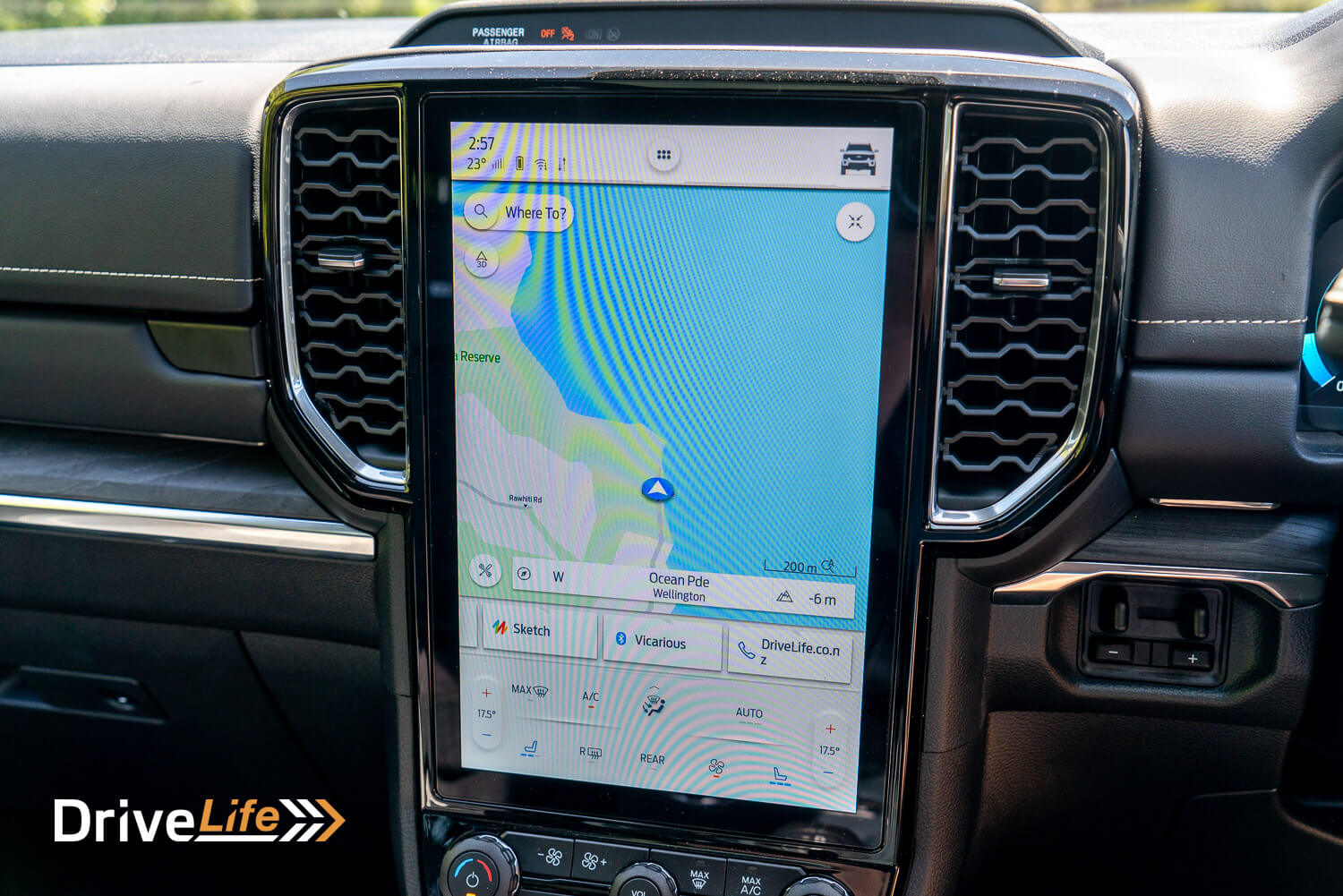
Returning to the star of the show, the 12-inch central infotainment is the command station for many of the Everest’s accessories and functions. A quick glance of the spec sheet will tell you the Everest is packed with tech toys, but in terms of the basics, the screen has good resolution, sharp colour levels and is quick to respond to touch. The user interface, which is Ford’s Sync 4, has a learning curve but is relatively simple once you’ve gotten your head around it.
However, it’s not all perfect. The infotainment’s portrait orientation means that the reverse camera view is quite small on the screen. Furthermore, many of the climate controls have been digitised. Ford does have physical controls for the temperature and fan speed, but not for anything else.
The heated seat controls are particularly bad. Ford has put their function on a digital slider, and it’s not very responsive. It makes it frustrating to adjust while driving.
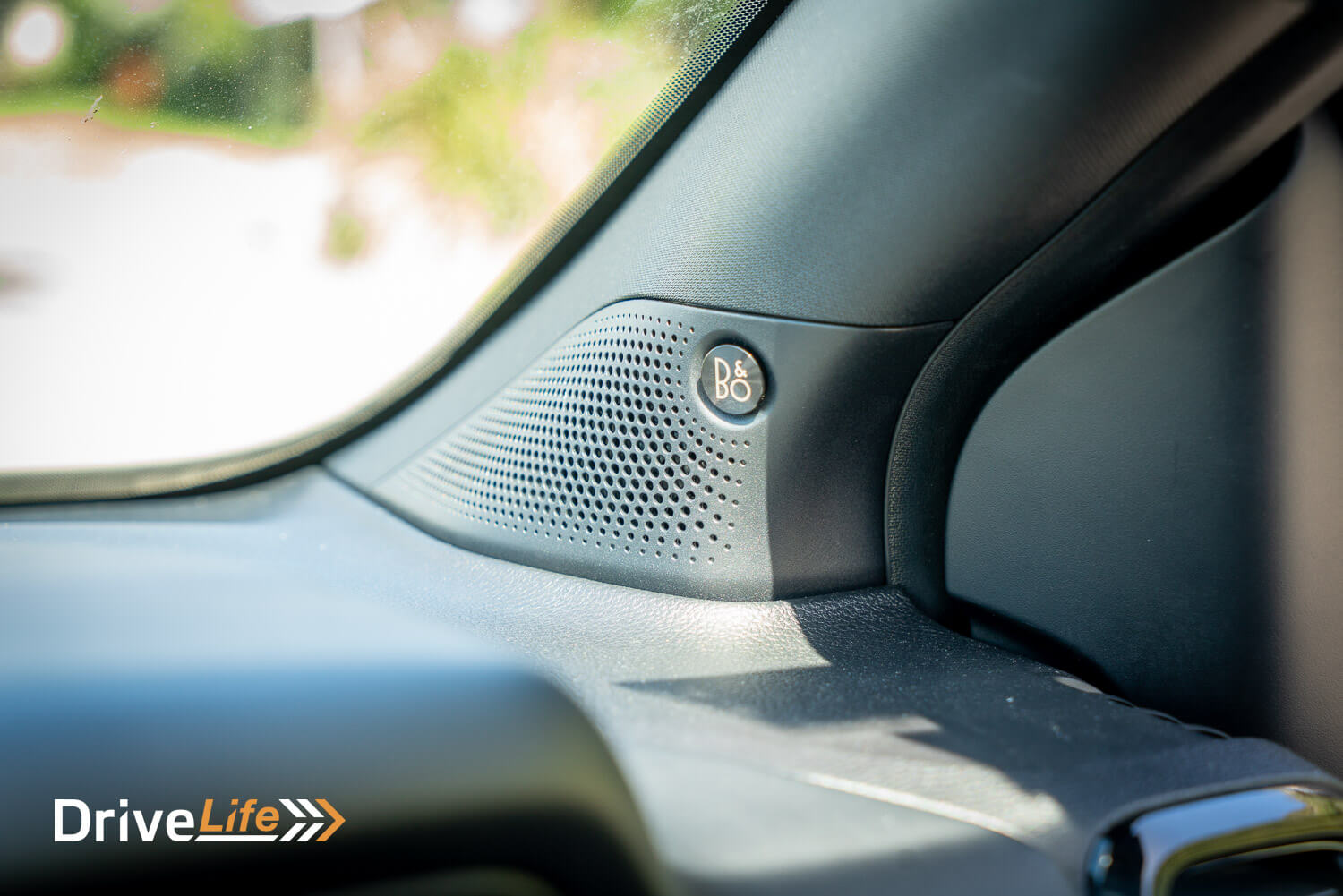
Aside from these quibbles, it’s all rather nice to use. Plus, the infotainment is paired with a 12-speaker Bang & Olufsen sound system, which is easily one of the better sound systems I’ve encountered at this price point.
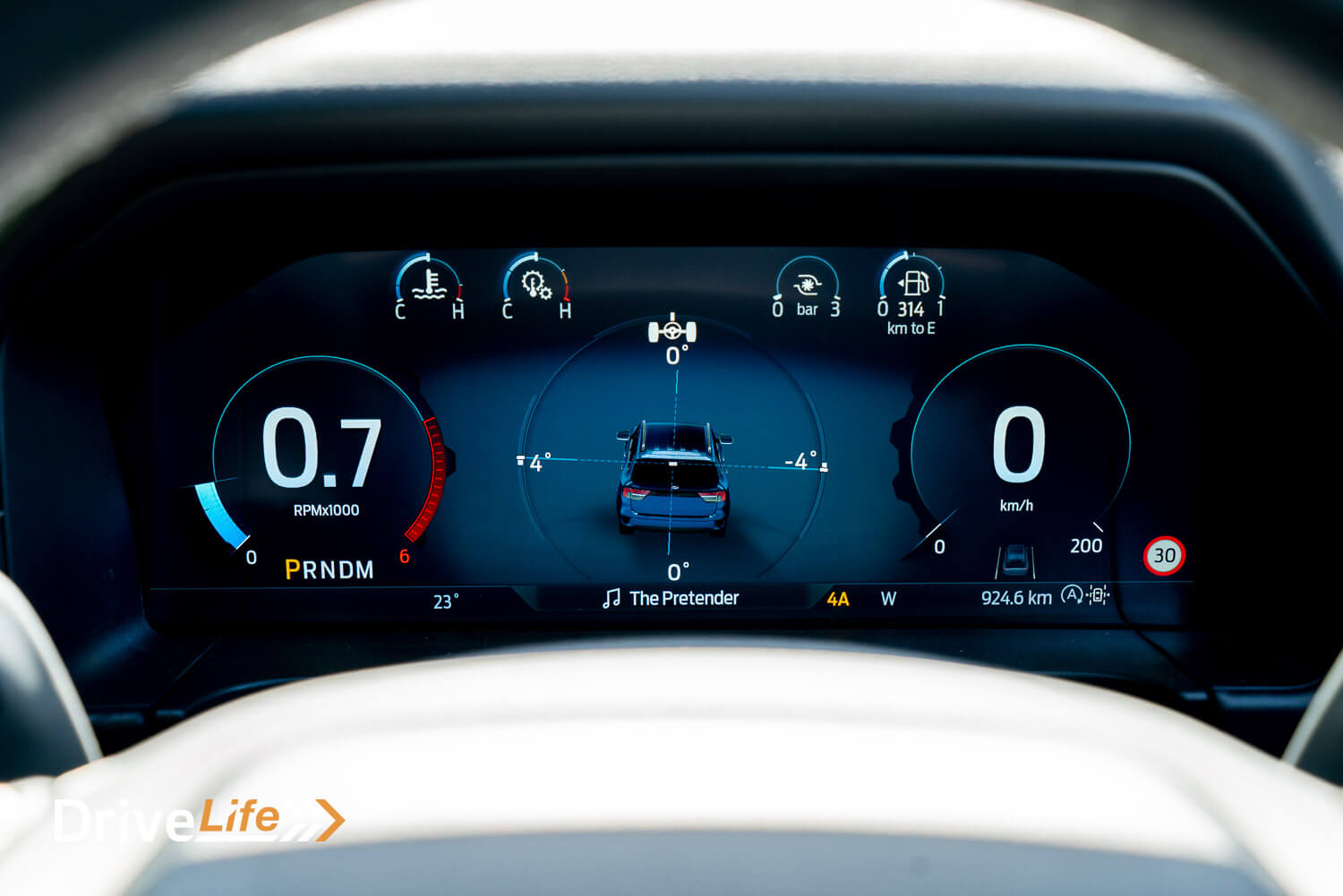
In front of the driver, the digital dash cluster is clear, has good resolution and offers several different displays based on the driving modes. There’s a small amount of personalisation between the screens too.
Once you’re done playing with all the tech, you’ll begin to appreciate the rest of the cabin. Particularly, the comfort and supportiveness of the front seats. However, I wasn’t sold on the driving position in the Everest. Once I’d set my comfortable position, I found that I had little headroom to spare. Conversely, if I wanted additional headroom, the seat would be too low for me to have a decent view out beyond the Everest’s sizable nose.
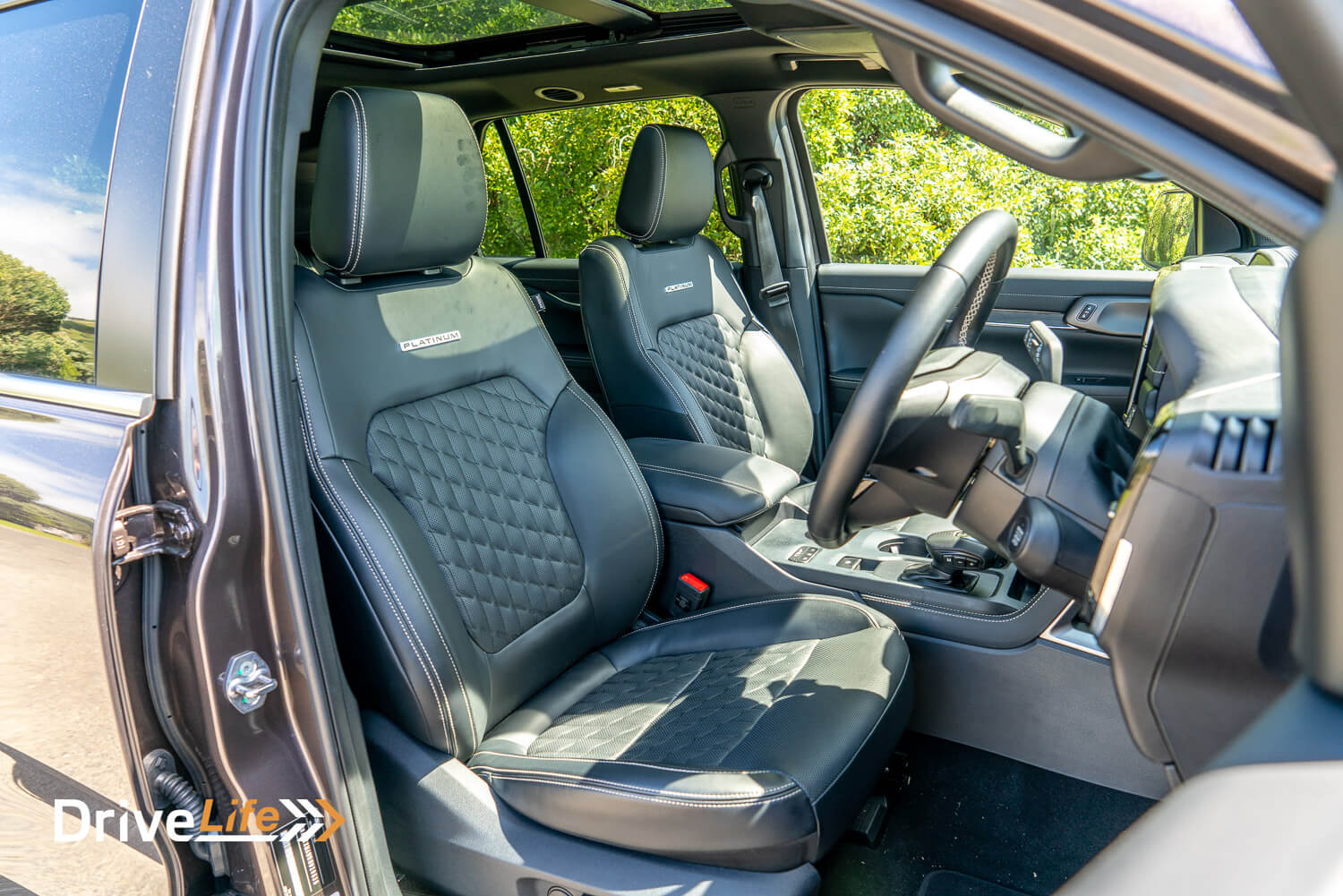
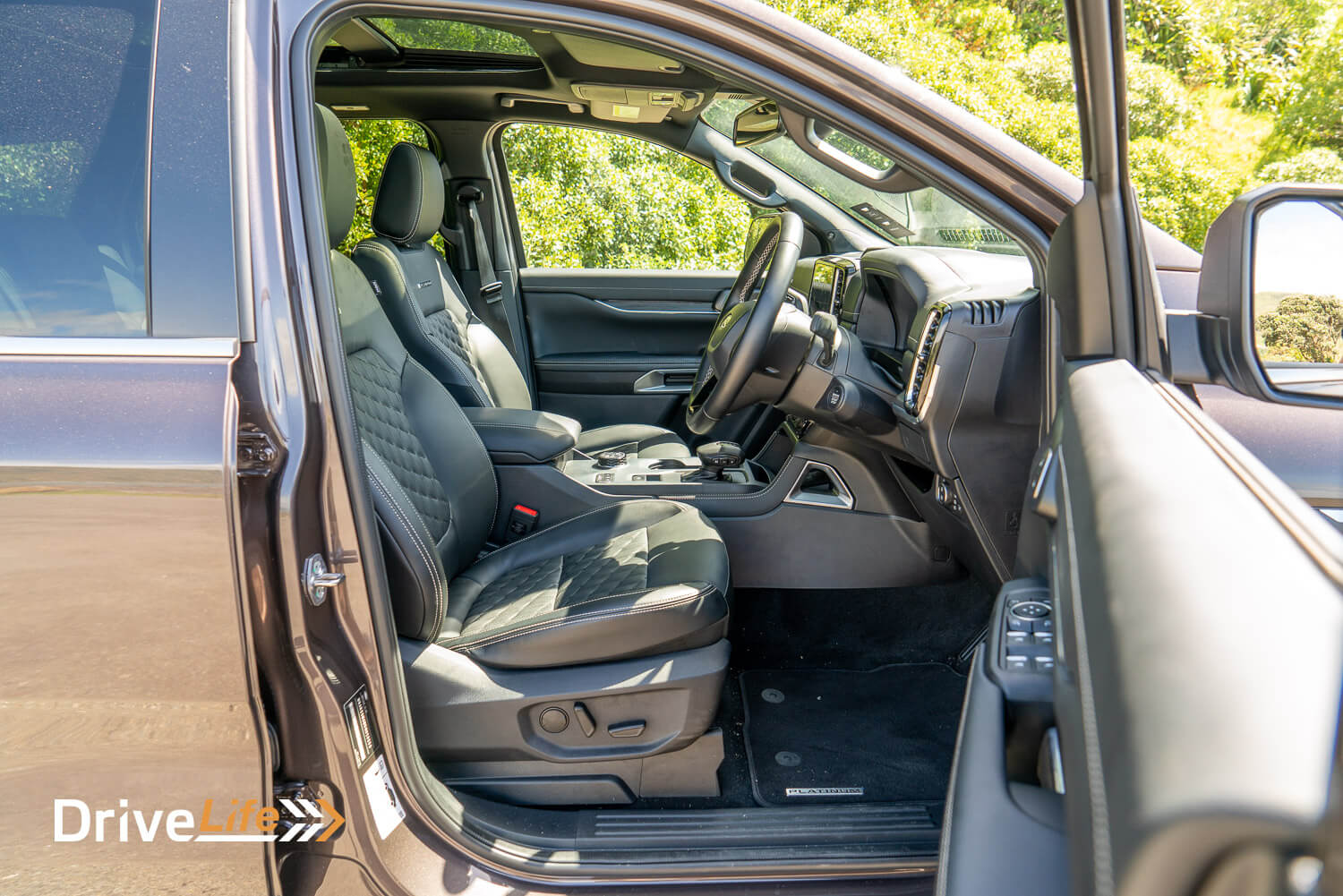
With all the focus on the front, one could forget to spin around and take note of the rear seat passengers. In the Everest, you have seating for seven, plus in the Platinum trim, you gain a large panoramic sunroof. Second row passengers have plenty of room to spread out, and the outboard passengers get heated seats. However, a downside of any body-on-frame SUV is that the floor is quite high, meaning that taller folk might find their legs more bent than usual in the rear seats.
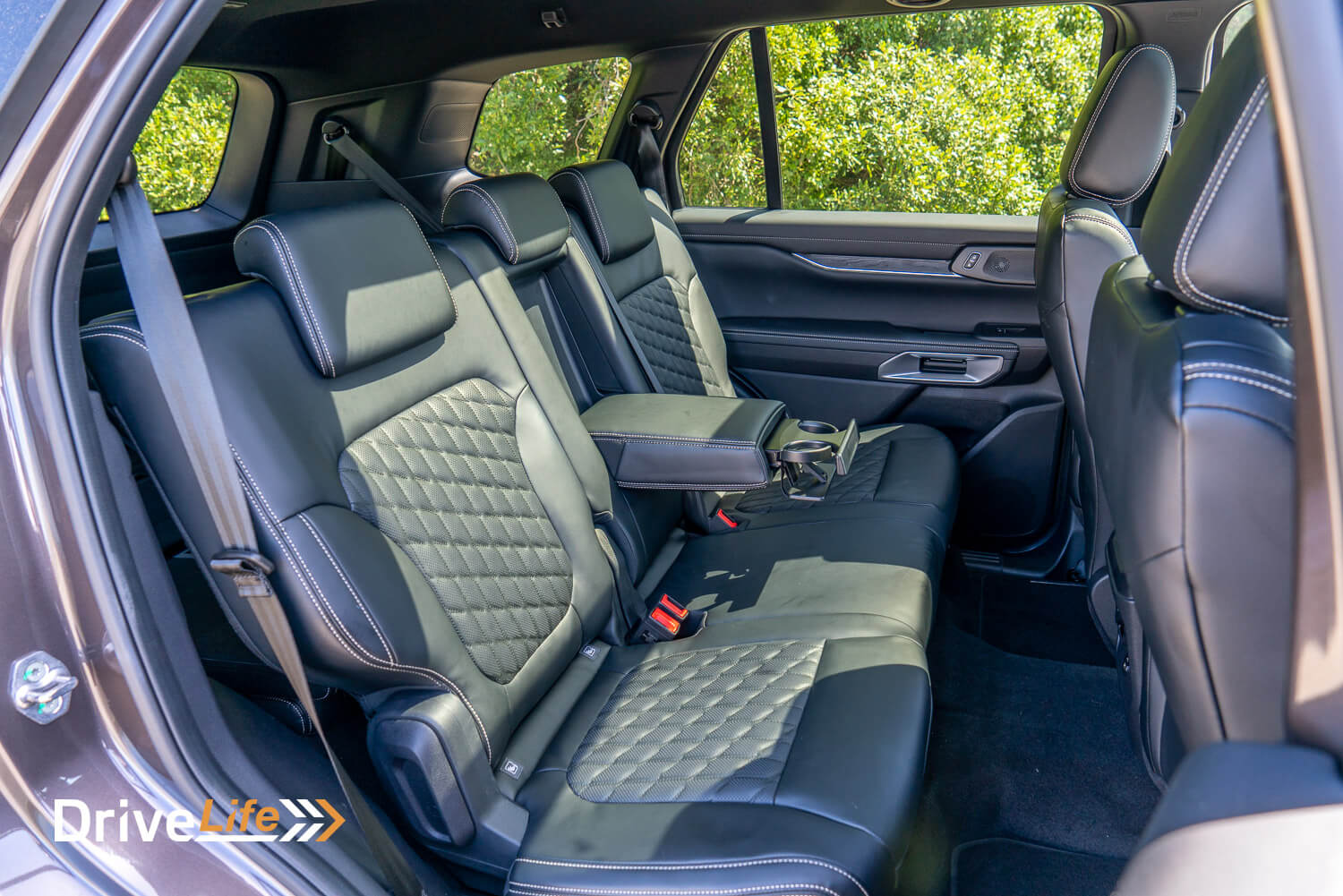
Like any 7-seat SUV, the third row is the designated space for children, or passengers you don’t like. There’s not much back there to keep them entertained either. The seats are electronically erected via a switch in the back, meaning there’s no faffing about with manual releases should you need to carry extra people. The Everest also offers a generous amount of cargo room. With the third row in place, you get 259L, and 898L with only the second row in place. Pop the second and third row down, you’ll get 1818L of space.
What’s The 2022 Ford Everest Platinum Like To Drive?
We live in an era of downsizing. So, it was slightly surprising when the new Ranger was announced, Ford would be including a bigger 3.0-litre V6 turbo-diesel to accompany the existing 2.0-litre 4-cylinder bi-turbo diesel. The Everest range offers both engines, and in our test vehicle, we’ve got the beefier V6. Hoo-rah!
Although, the V6 is not an all-new engine from Ford. The V6 is Ford PowerStroke V6 engine, also found in the 2018 Ford F-150 over in the United States. However, the PowerStroke V6 has been heavily modified for the Everest and the Ranger. In our Everest, the V6 is outputting 184kW of power and a whopping 600Nm of torque.
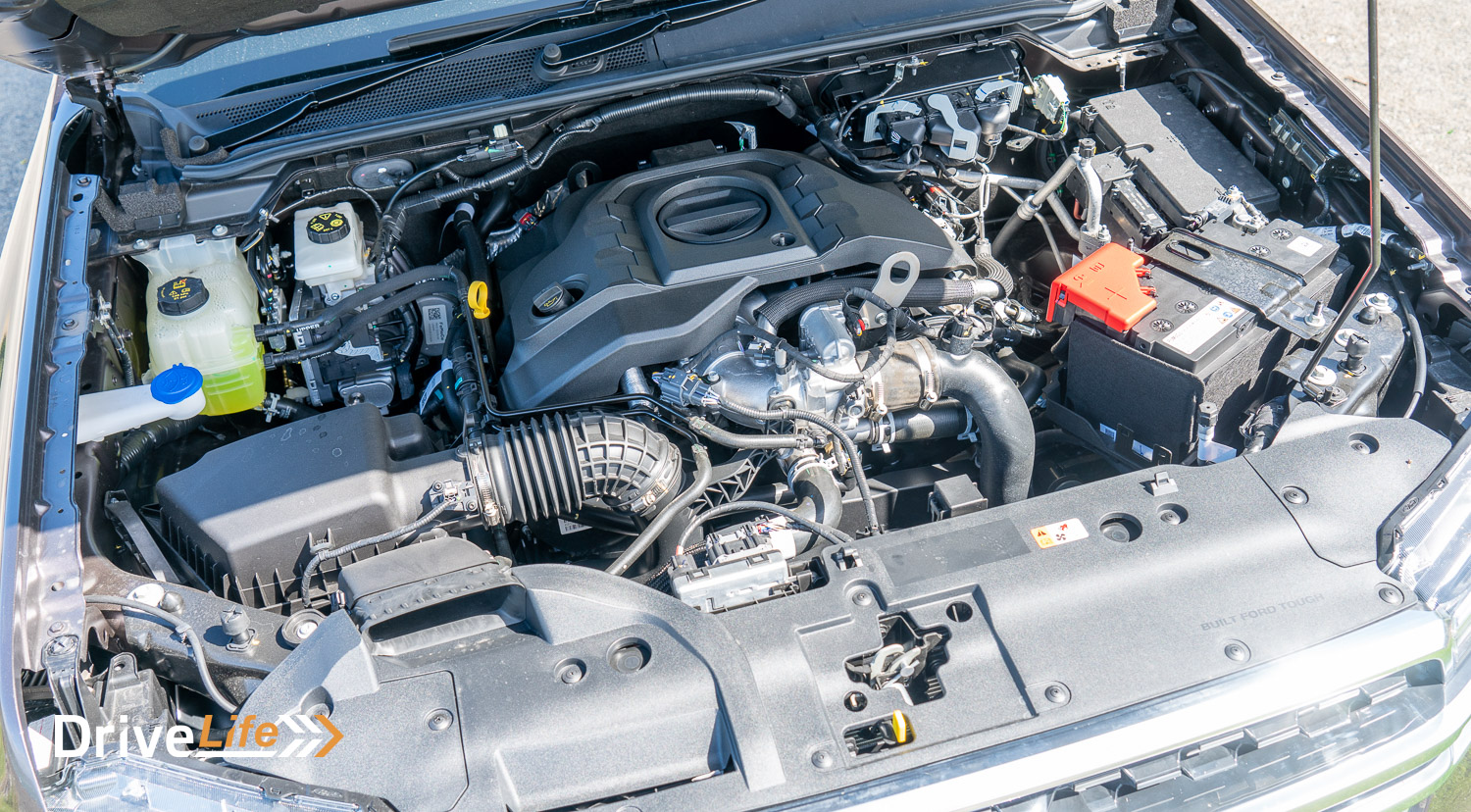
Despite needing to haul a 2,492 kg body, the V6 has effortless power. The Everest always feels ready to stretch its legs. It has a consistent and linear delivery, along with abundant torque-on-tap, it seldom feels out-of-breath when you’re putting it under pressure.
Though the best thing about the V6 is its refinement. Honestly, you might be putting diesel into the fuel tank, but you’d be easily convinced it’s a petrol. It’s smooth and quiet, and there’s so little engine noise made at motorway speeds. Instead, you’re more likely to notice the wind and tire noise. Not that there’s a great deal of noise from either anyway. Sure, you will notice the diesel traits when you push into the higher revs, but you needn’t often go there given the mid-range performance.
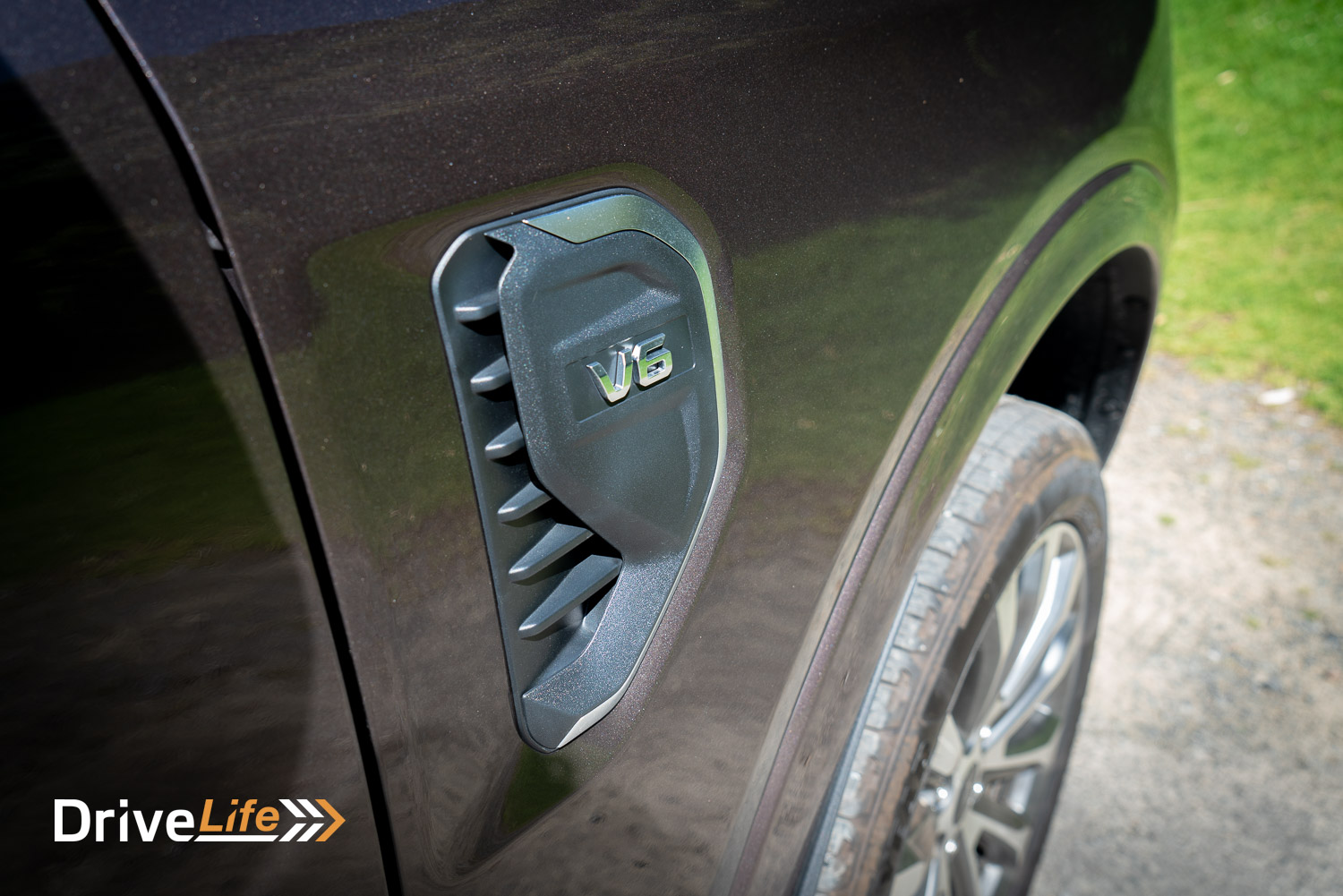
The 10-speed automatic paired with the engine is also an excellent unit. Gear changes are short, sweet and smooth. You won’t catch it hunting for gears, meaning you’re unlikely to encounter any engine sluggishness with this gearbox. This gearbox is easily one of the best you’ll find in this class of SUV. Mentally, I was comparing it with the gearboxes found in more expensive vehicles.
The fuel consumption isn’t bad either. Ford claims a combined economy average of 9.7L per 100kms. We managed an average of 11.2L by the end of our test.
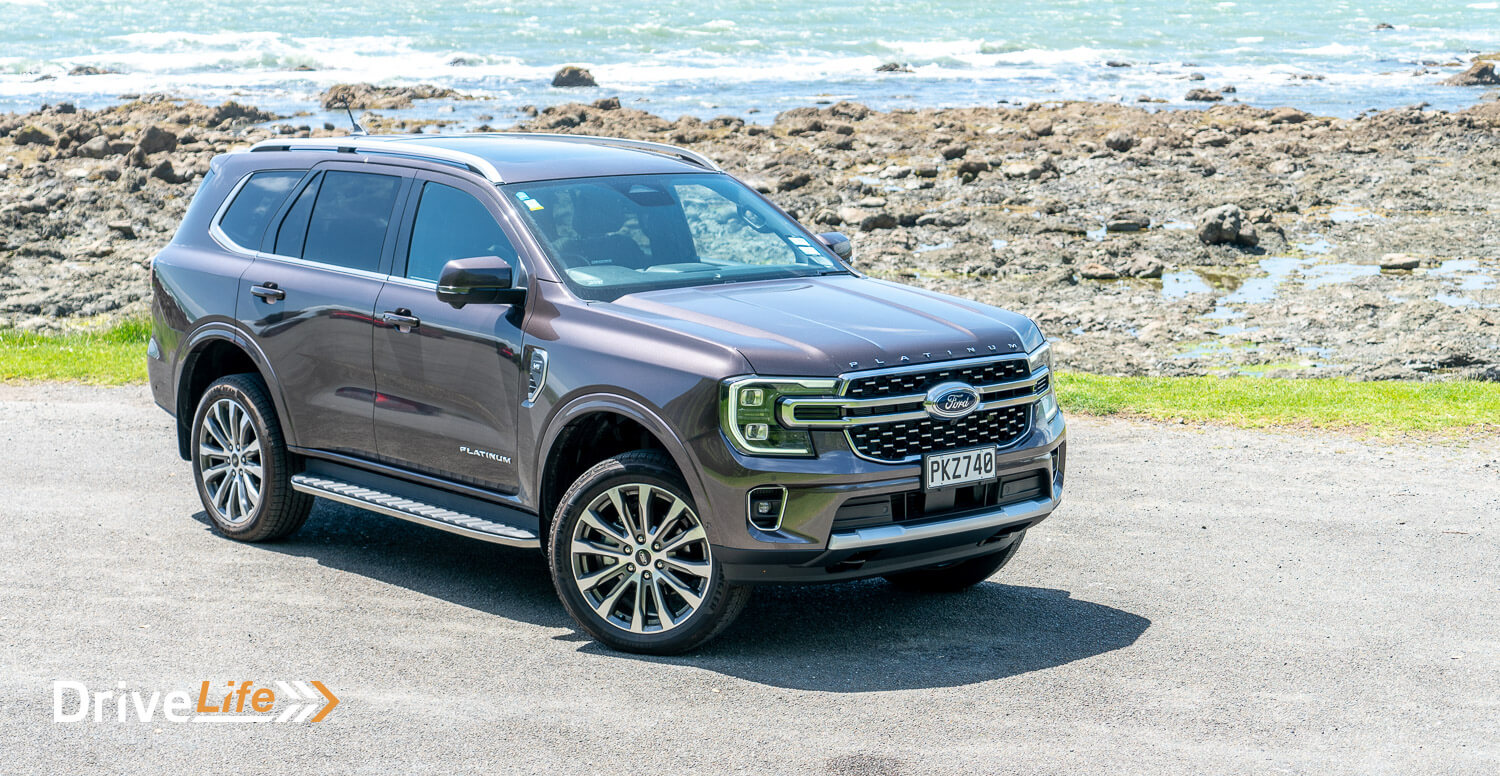
Anyway, that’s enough about the powertrain. Another major reason why Ford’s Ranger is so popular is due to the chassis.
Ford’s utes and trucks are among the best-selling vehicles in the world. In fact, the F-150 has been the top selling vehicle in the United States for 40 years! Because of this, Ford has afforded years of development time and devoted stacks of money refining their truck platforms.
In the case of the Ranger, it still has a ladder frame and has a leaf-sprung rear-end, but Ford has somehow made a conventionally hard-riding chassis feel like a family crossover.
The Everest uses the same chassis as the Ranger, and is a beneficiary of Ford’s continuous chassis tinkering. The Everest also benefits from a multi-link rear suspension setup, instead of using the Ranger’s rear leaf springs.
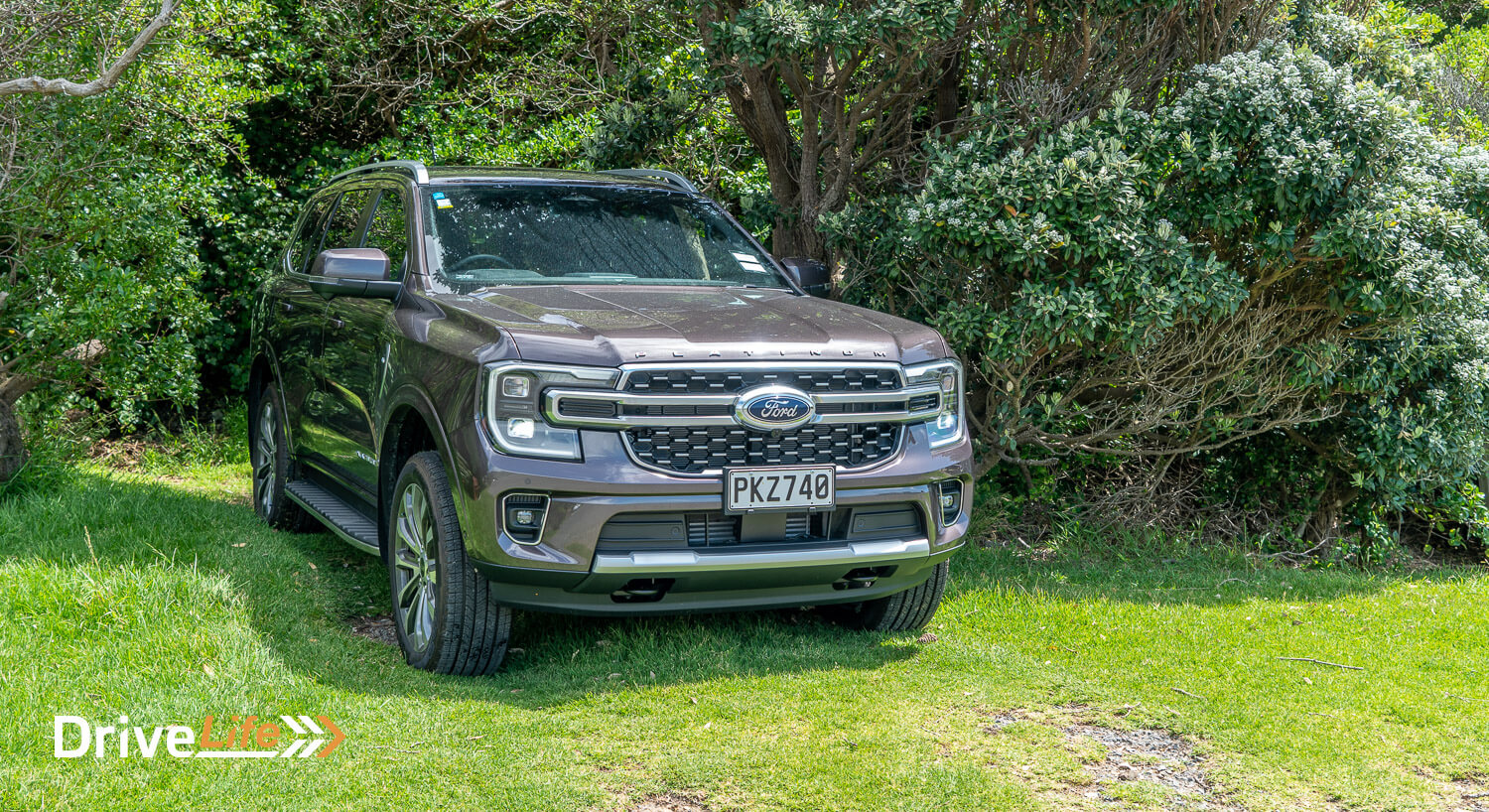
As a result, the Everest has good road manners for a large SUV. Body control is good, meaning that quicker than usual corners are dealt with in an undramatic fashion. The ride quality is also a step-above others in the class, particularly when compared to Isuzu’s MU-X, another Ute-based SUV.
Another advantage of sharing the Ranger’s ladder frame chassis, means that the Everest has proper off-roading and towing credentials. It has the proper equipment to go with it too, including a rear locking-differential, a series of external camera views to assist with spotting, and several off-road and towing driving modes.
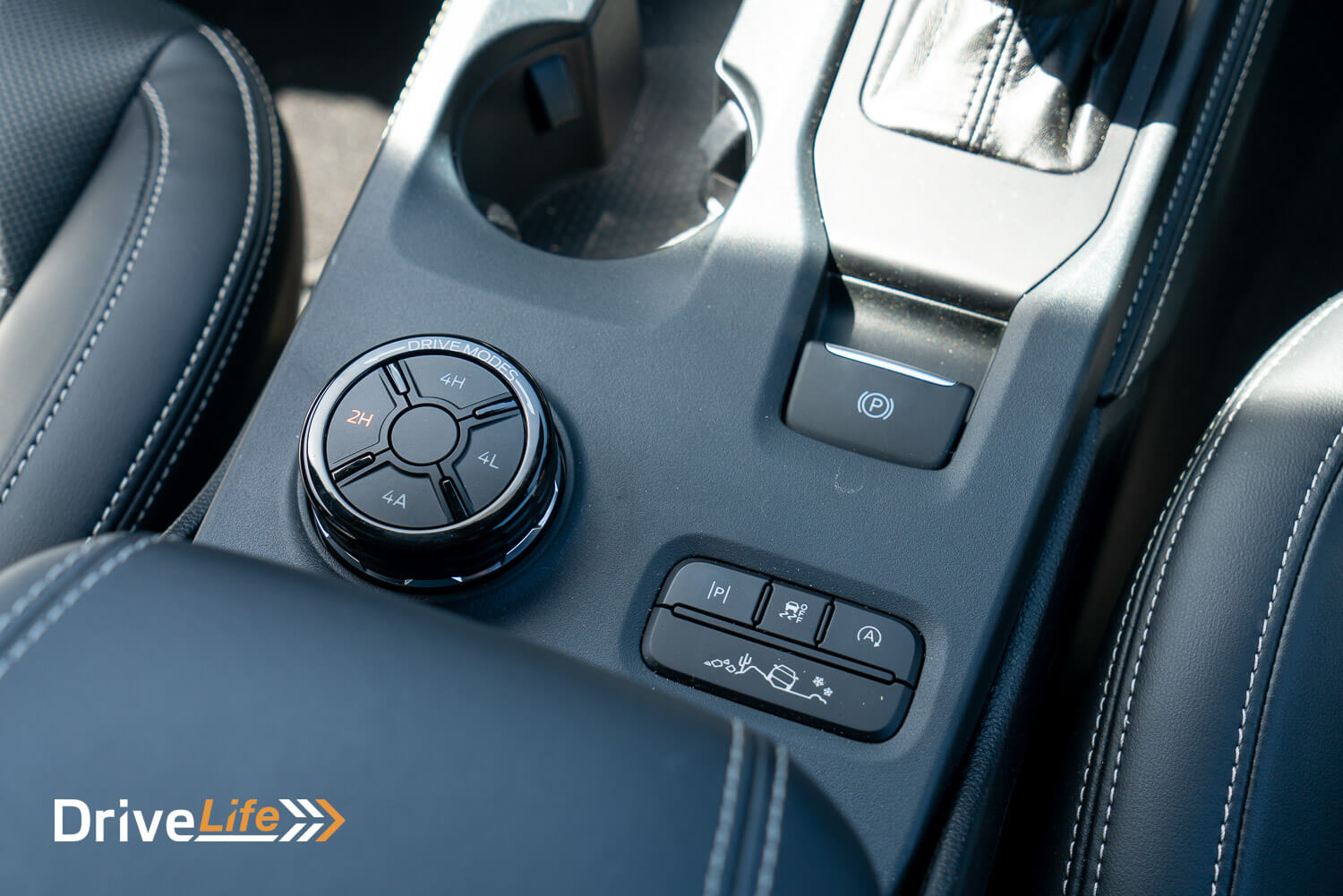
The various off-roading modes will automatically optimize the drivetrain for the terrain. Alternatively, you can play with these settings yourself using the rotary dials and buttons on the centre console. The main dial allows you to shift the Everest between 2H, 4H, 4A and 4L (H for high-range, A for auto and L for low-range). 4A is ideal for towing, shifting the Everest in full-time 4-wheel drive. Handily, the Everest also has a Tow mode, which programs the gearbox to hold gears for longer when travelling with a trailer. There’s even a handy safety checklist for towing in the infotainment too.
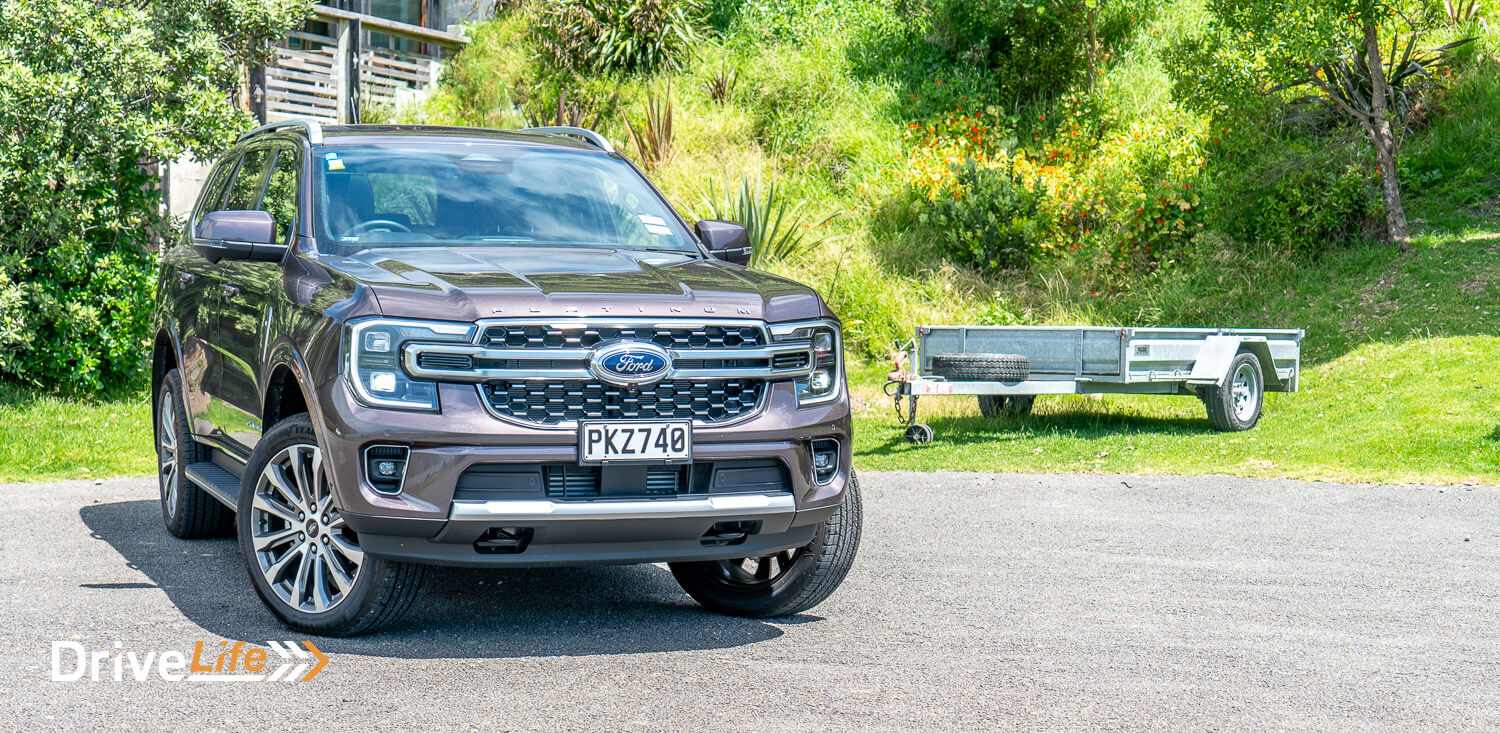
Unfortunately, we didn’t get the opportunity to off-road or haul a load with the Everest, but Fred has tackled some rough stuff in a Ranger in the past. We’d expect the Everest to perform similarly, if not better, given the rear suspension set-up along with the added weight over the rear axle.
Like any modern vehicle the Everest is equipped with all the modern driver’s assistance technology. These systems aren’t equal across all cars. Some brands do it noticeably better than others. In the Everest’s case, the tech is very good. The adaptive cruise control is well calibrated, being smooth and linear with its inputs, and operating down to a halt. Similarly, the lane keep assistance is well calibrated. You can invest a good level of confidence in the software on the motorway, which is something I can’t say that for all SUV’s I’ve tested.
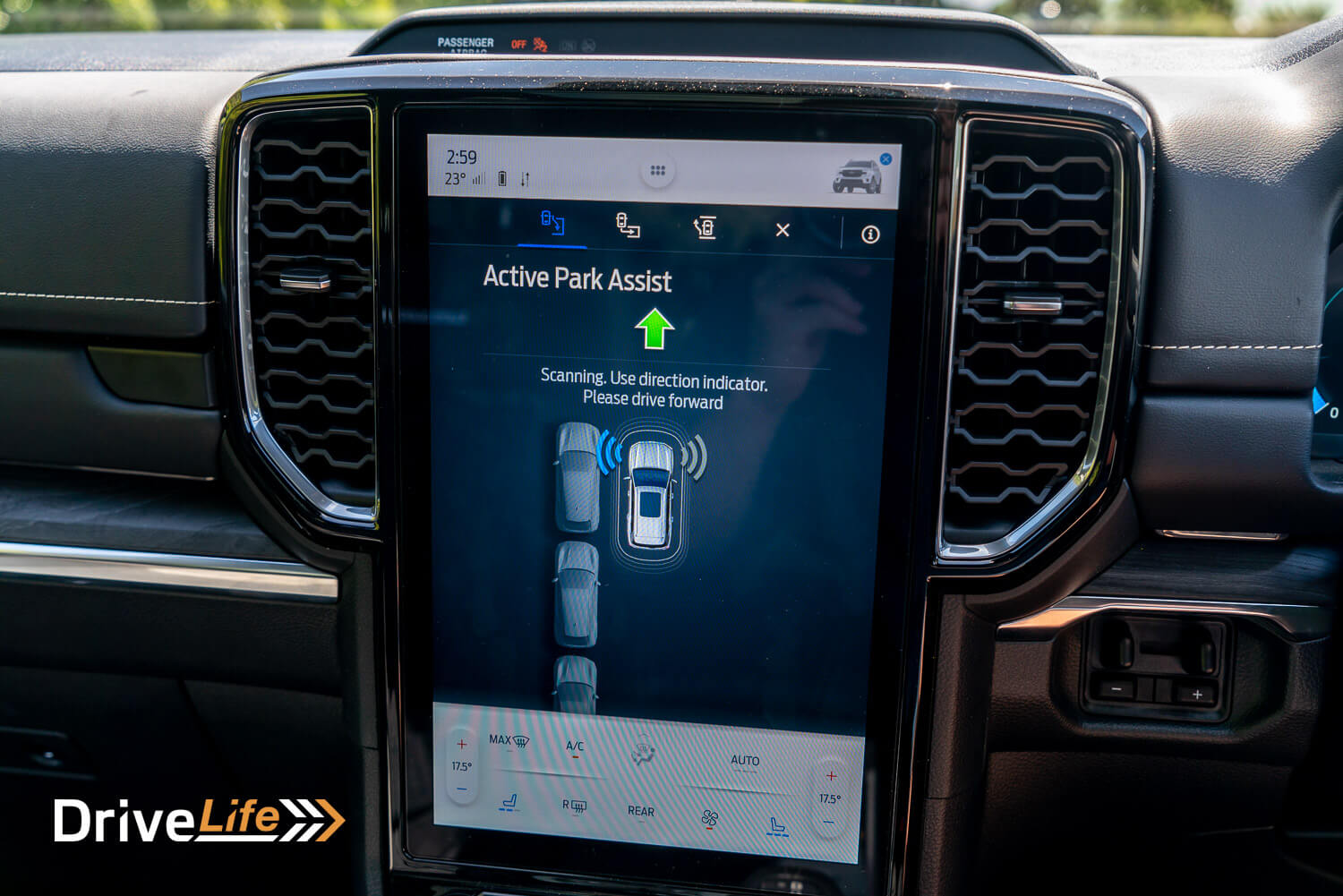
Being the Platinum model, our Everest is equipped with Ford’s Active Park Assist, which will self-navigate this beastly Everest into a car park of your choosing. These features are often reserved for the prestige marques, like Mercedes, BMW and Audi. It works well too, but I’d think twice about using it in a complex environment, mainly because the set-up and execution occurs at a leisurely pace, which may bother some motorists around you.
I often found it just easier to do it the old-fashioned way. Still, it’s pretty handy for those tighter spots which you might have less confidence with.
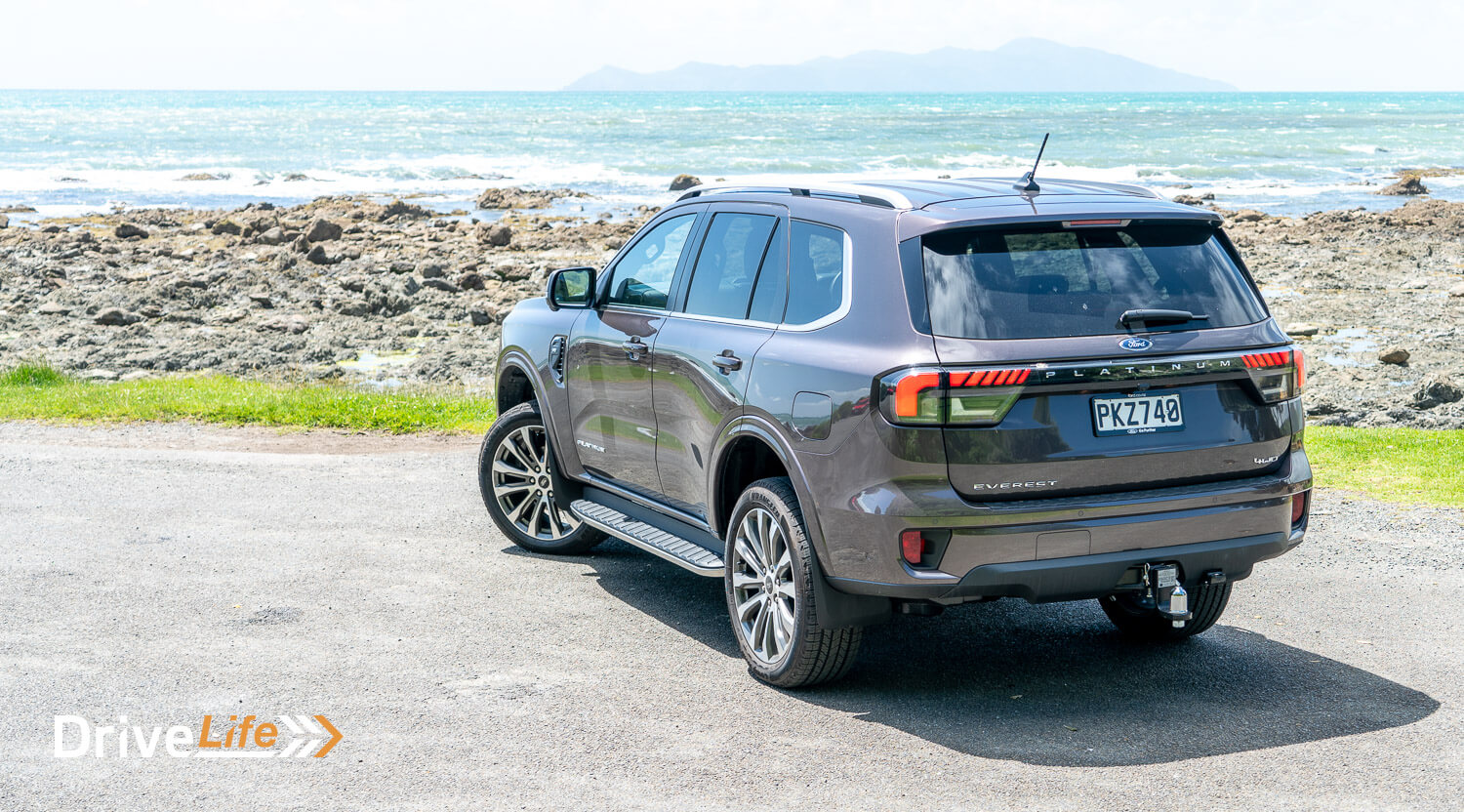
Fred’s Point Of View
After driving over 1,000km in the V6 Ranger, I was very much looking forward to spending some time behind the wheel of the V6 Everest. It felt a lot bigger and heavier on some of Wellington’s tighter streets, but still that engine shines. It’s such a great motor; smooth, torquey, with plenty of overtaking power.
While the Ranger I reviewed was a Sport model, the Platinum level of Everest really lifts the bar for extra features and luxury. On a few hot days I really appreciated the ventilated seats. The seats are supremely comfortable as well as looking like the luxury model seats that they should be. Inside, there were more hard plastic finishes than I had expected, but I need to keep in mind this is still a vehicle meant for muddy boots and dirty dogs.
The upgraded B&O sound system sounded excellent – for some songs, it felt like a truly live music session.
All in all, the Everest performed as well as I expected it would, and to me it’s no surprise it’s in the Top Ten for Car Of The Year.
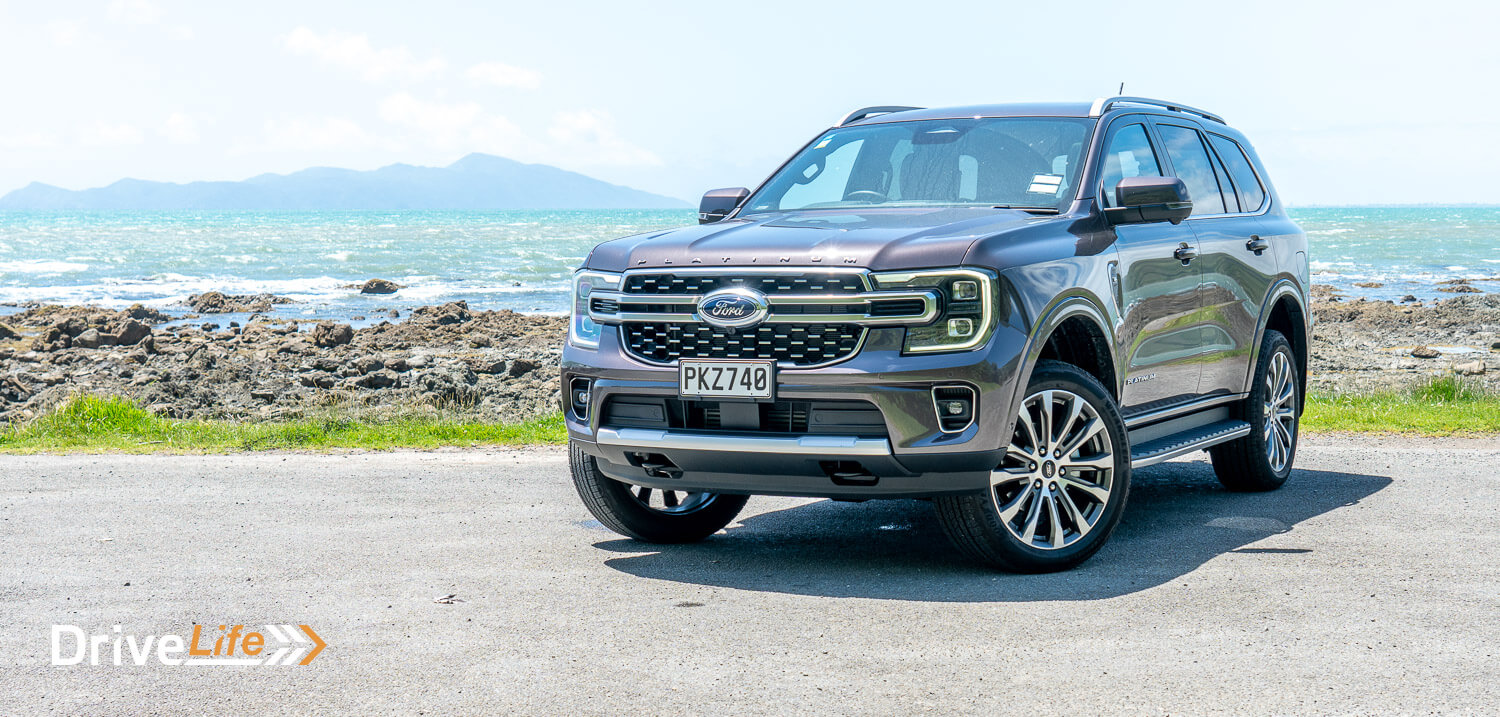
2022 Ford Everest Platinum Specifications
| Vehicle Type | Full-size 7-seat SUV |
| Starting Price | $86,990 |
| Price as Tested | $86,990 |
| Engine | 3.0-litre turbodiesel V6 |
| Power, Torque, kW/Nm | 184@3,250rpm 600@1750-2250rpm |
| Transmission | 10-speed Automatic transmission |
| Spare Wheel | Full size |
| Kerb Weight, Kg | 2,492 |
| Length x Width x Height, mm | 4940 x 2207 x 1837 |
| Cargo Capacity, Litres (3rd row up/3rd row down/2nd row down) | 259/898/1,818 |
| Fuel tank capacity,litres | 80 |
| Fuel Economy, L/100km | Advertised Spec – Combined – 9.7 Real-World Test – Combined – 11.2 Low Usage: 0-6 / Medium Usage 6-12 / High Usage 12+ |
| Towing Capacity Kg, unbraked/braked | 750/3,500 |
| Turning circle, metres | 11.8 Small: 6-10m / Medium 10-12m / Large 12m+ |
| Warranty | 5 year / unlimited kilometre warranty |
| Safety information | ANCAP Rating – 5 stars Rightcar.govt.nz – 5 Stars |


